Dinosaur Planet: Broncosaurus Rex by Fossilized Rappy
A Brief and Confounding History of the Future
Original SA postdwarf74 posted:
Wow.
How the hell have I never heard of this?
Broncosaurus rex was quite a short-lived series, even compared to its brother XCrawl. Out of the three titles released for it, one was the core campaign book and two were bestiaries, and most of the factions never even got fleshed out. There were whispers and rumors of maybe having a revised version for d20 Modern or even D&D 4E, but nothing ever came of it, and B. rex went extinct much faster than the reign of the primeval creatures it depicted.
Still, that's kind of jumping the gun. I should probably start at the start, shouldn't I? Let's get into the core campaign book...

Chapter 1: The World of Broncosaurus Rex
A Brief and Confounding History of the Future
It's time for a history lesson, folks! The story of B. rex's divergence from our real world begins during the Civil War. What happened differently from our timeline? Well, Lincoln was assassinated before he could make the Emancipation Proclamation, General Sherman was repulsed before he could make it to Atlanta, and the bolstered Confederates shoved back the disenfranchised Union. Not much is said about what happened directly afterward, besides that Robert E. Lee freed the slaves in 1881 out of the kindness of his heart and that the Confederacy and Union sort of just decided to keep to a state of cold war since one couldn't forcibly take over the other. But wait, what's this? 1960s space race like in real life, you say? Without the fight between the Soviet powers and the unified west, who ever put their feet on the moo-
quote:
The war continued full force into the space race. In the late twentieth century, it was a rebel astronaut who made the first foot-steps on the moon. Although the Union was industrially superior to the Confederacy, it lacked the adventurous spirit of the rebels. Richmond managed to build and launch Dixie 1 entirely on the basis of stolen technology and kidnapped scientists. The Dixie survived the trip, landed on the moon and ejected Lance Whittacre, who claimed the moon for the Confederacy.
 Well then.
Well then.
The plucky Confederacy continues its winning streak after getting their man on the moon, taking Mexico and Central America as parts of its territories before beating the Union both to colonizing Mars and sending exploratory vessels through
quote:
But the Union’s manifest destiny knew no limits. The Confederacy’s successful diaspora still rankled its sense of might. Now that it had Earth, it hoped to conquer the stars.
And so the Union heads to the stars with spaceships that still have 1800s design aesthetics and steampunk mecha the Union has dubbed "ironclads", ready to pound the Confederacy into the ground once and for all. Their final battleground? A strange planet called Cretasus.
On Cretasus
The surface of Cretasus is basically one huge landmass divided into twenty valleys (though only two are ever actually detailed) all separated from the others by immense mountain ranges. Inside of these valleys are dinosaurs and other prehistoric life, though not quite as we know them. You see, Cretasus has mostly sapient life, with things like Tyrannosaurus dynasties and Protoceratops libraries dotting the landscape of the central valley. Pretty much all of what you will ever see out of the game is from the central valley, as the only other valley ever detailed is the freakish Storm Valley, but that's a story for another time. After all, this is the core book, which barely details the central valley at all! For that, you'll have to wait for the first supplement of the game.
-----------------------------
Coming up next: creating a character, from faction to class and everything in between.
Civil Wars: Factions
Original SA post
Chapter 2: Character Creation
Broncosaurus Rex is one of those games that sort of assumes you are going to play a human, nevermind the awesome intelligent dinosaurs. While we will get into some "[X]saurs as Player Characters" sections once we reach the bestiary, the actual character creation chapter pretty much outright says you are meant to play a human. Instead, there are different playable human "races" in the form of places of origin. Your place of origin is basically what faction you were born into, and what that grants you. You get the choice between:
-
Confederate:
Congratulations, you were born into the faction the game tends to favor above all others! You are considered to be a kind and adventurous gent from a simple down-to-earth life. As a Confederate, you get a free bonus feat, a free fancy heirloom weapon, a proficiency with old timey weapons such as knives and bows, and a +1 bonus to animal-related skills (Animal Empathy, Handle Animal, and Ride).
-
Union:
Being a member of the Union means you're that snooty asshole that speaks your mind and the Confederates hate you, and you are either a high-strung overachiever or a bumming underachiever with few chances for room in between. As far as benefits go, you get free proficiency with ballistic weapons such as firearms, 4 extra skill points at first level, +1 Intelligence, a +1 bonus to checks with the Use Technical Equipment skill, and the ability to actually learn how to pilot an ironclad mech.
-
Free Fleet:
You're a stereotypical gypsy, but in space. Free Fleet members basically hate the Union and somewhat tolerate the Confederacy, and sort of go from system to system selling their wares and sometimes ripping people off. Yay. For your in-game benefits as a "Freeman", you get +1 Dexterity and a +2 bonus to Appraise and any one Knowledge check.
-
Offworlder:
The Offworlder origin is basically a catch-all for anyone outside of the three previous faction origin. You get +1 Constitution and Strength, -1 Charisma and Intelligence, and a +2 bonus to Intuit Direction and Wilderness Lore. Yes, the game actively holds contempt for you, you sorry no-factioner. Why can't you be more like those heroic Confederates?!

If you haven't noticed by now, the Confederates get a lot of attention compared to the other factions. No, the screen time doesn't get any more balanced from here on out, either.
Classes
After picking a place of origin, it's obviously time to choose what class you want to be. You get six classes to choose from as follows:
-
Bronco Rider:
The class that puts the "bronco" in Broncosaurus Rex, the Bronco Rider rides dinosaurs. That's pretty much it. Some mounted combat feats, an animal companion, and a dinosaur mount. The class gets good Reflex saves as far as stats go, but everything else is pretty average.
- Machinist: Meet the Machinist, the backbone of the Union and a decently common class in the Free Fleet. As a Machinist, you have some pretty good Reflex and Will saves, as well as an ever-growing ability to customize weapons and technology to your own purposes. In addition to increasing attack or damage roll bonuses to a weapon, you can also alter other factors such as range, rate of fire, and critical chance. Machinists are pretty much the best thing the Union has going for them as far as special game rules, and they'll seem even better once we get to the first sourcebook. If there is any real drawback to the Machinist, it's that you are apparently likely to look like a gear gnome, if the book's art is anything to go by:
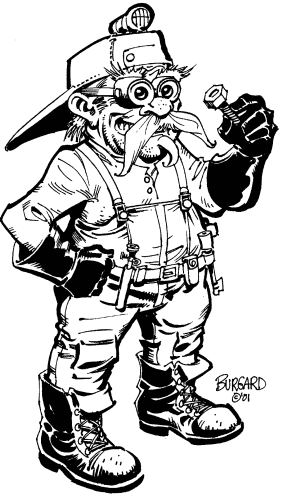
-
Soldier:
Basically a Fighter, but with guns. You get a good Fortitude save and maximum Base Attack Bonus progression, proficiency with pretty much any weapon or armor you could want, and some combat-related bonus feats.
-
Spy:
The suave and sometimes sinister agent of the shadows, the Spy class is pretty much what you'd expect - lots of focus on dodging, speech-related skills, and conflict avoidance. What is rather baffling, though, is that the Spy actually gets a higher Base Attack Bonus progression than the Bronco Rider. I would have figured the gritty dinosaur-riding cowboy would be more prone to punching me out than the class that is specifically stated to avoid direct combat.
-
Two-Fister:
The Two-Fister class is mostly a pretty straightforward brawler, with decent BAB progression and bonuses to both the attack rolls and damage of unarmed strikes. You also do get one interesting non-combat ability, though, in the form of Local Connections. This class feature grants the Two-Fister a bonus to Gather Information checks equal to your total levels in this class, with either further bonuses in familiar territory or penalties to the check in territory held by a direct enemy.
- Wild One: Last, but certainly not least, of the new classes is the Wild One. The Wild One is a human that has gone to the side of the dinosaurs and gains dinosaur allies that help him protect the wilderness, as well as a bonus to fighting some form of civilization such as Union machinists or Confederate dinosaur riders. This enmity is combined with a hatred for other humans, which means that a game with a Wild One character is pretty likely to be entirely made of Wild Ones or a Wild One combined with non-human party members.
As you might have expected, the classes overall are weaker than anything you see in standard D&D - after all, you have no shapeshifters, spell-slingers, or the like. The classes are also pretty much the only place where a member of the Union can get a leg up, as the typically Union-focused Machinist does have a lot more appeal than the typically Confederate-focused Bronco Rider.
Skills
After your classes, you get some new skills and skill uses. The skills Drive, Pilot, and Operate Ironclad are both self-explanatory and really aggravating, as there is not a single vehicle or ironclad mech to be found in the entirety of this core book. The other new skills are pretty much all class-focused skills as follows:
-
Animal Empathy:
It's like Diplomacy, but with animals. You get access to this skill as a Bronco Rider or Wild One, and only the Spy is allowed to take it as a cross-class skill.
-
Cipher:
This is a purely Spy-only skill. No one else gets it as even a cross-class skill, even though I would think that at least Soldiers would be able to learn how to code and decode military ciphers as the skill allows.
- Read Lips: The third of three class-specific skills is also one of two that is Spy-only, just like the Cipher. To be quite honest, I can't really comprehend why only the Spy should be able to learn how to lip read, either.
-------------------------------------
This post went on longer than I expected, so character creation is going to be split here. Next post, we'll be looking at feats, equipment, and gadgets.
Feats of Fancy
Original SA post
Chapter 2, Take 2: Character Creation Continued
Feats of Fancy
The section for new feats is surprisingly light, actually. Other than some re-sorting of weapon proficiencies, feats that grant a +2 or -2 to some check, a feat that allows some sort of reroll, a feat that lets you talk to dinosaurs more effectively, and the Soldier's combat maneuvers, there's not a whole lot you get that is across the board. Still, let's be fair and take a look at a few of the less utterly bland ones.
-
Death Wish:
With the Death Wish feat, you can keep fighting into negative hit points, but at the cost of penalties to your attack rolls and losing double the amount of HP per round. So, really, this is basically a feat you only really use if you feel the DM won't let your charaacter survive this game no matter what, and you at least want to go down swinging.
-
Trick Shot:
A “one free stunt ticket” feat. Once per day, you can do a stupid and normally impossible feat of firearms manipulation such as doing a bouncing shot or splitting a bullet to allow you to hit two targets with full force. You get to make a rather weak (DC 10, to be exact) check, and if you succeed, you get a +8 bonus to to attack roll on the trick shot.
- Turncoat: In addition to the normal “+2 to the usual suspects list of Charisma-based skills” spiel, getting this feat also means you suffer no Charisma penalties when dealing with direct enemies.
Of course, there are also three faction-related feats. Take a wild guess who gets all of the faction-related feats in the feats section.
If you guessed "Confederates", congratulations, you aren't blind. If you're a Confederate character, you get access to three feats no one else can access:
-
Gentry:
You get a +2 bonus to Charisma bonus when dealing with other Confederates thanks to your aristocratic blood. While this is kind of bland, I have to mention it because no other factions get such a feat. You’d think that something like “Renowned Trader” for the Free Fleet or “Favored Scientist” for the Union would also exist, but nope, just one for the Confederates!
-
Great Lover:
You turn into Confederate James Bond. You can sex your ways out of situations, getting a +1 bonus to Great Fortitude and Will saves on top of a +2 bonus to Charisma checks against individuals of the opposite sex. There are apparently no Lotharios out there in the Union, Free Fleet, or Offworlders.
- Rebel Yell: Your whooping and hollering allows you to invigorate your allies into gaining a +1 bonus to attack rolls for 1d4 rounds. Because apparently there is no such thing as a battle cry for the Union, Free Fleet, or Of-yeah, I’m just going stop myself there instead of repeating my same point a third time.
As you can probably see, my opinion is that the three Confederate-only feats are pretty bullshit. None of them couldn’t be adapted for the other factions, and the only reason they are Confederate-only seems to be to further stroke the ego of the “heroic Rebels” archetype the game tries to build up. I’m not even saying that every faction but the Confederacy should get special feats or anything like that. I’m not against giving the Confederates faction-only feats. What I’m against is giving them three but giving the others none.
We Have the Technology: Tech Levels and How They Work
Technology in Broncosaurus Rex is sort of an eclectic mes, and the start of the equipment section attempts to deal with that. Humans in the setting have very much become consumers rather than producers, with pretty much any weaponry above a high-powered rifle coming from aliens that the Free Fleet trade around with. There are also some technologies that simply don’t exist – the warp gates mean that faster-than-light travel contained within a spaceship never developed, neither the Union nor the Confederacy ever took the time to split the atom for some reason, and trends in the design of architecture, clothing, spacecraft, and weaponry never really went past the 19th Century aesthetic.
The segment introduces a “Tech Level”, which goes from 1 (clubs, swords, and other basic “stick pointy thing/smashy thing into other person” tools) to 20 (alien teleporter technology), to deal with the question of what technology your character can actually use. Your total tech level is based on your faction of origin plus your Intelligence modifier.
To demonstrate this, let’s say that we have a Confederate character named Tom. Being from the Confederacy, Tom’s base tech level is 4 – an understanding of basic Cold War era technology like the AK-47 and early fighter jets. Tom is rather clever, though, having an Intelligence score of 16. This gives him a +3 Intelligence modifier bonus to his tech level, bringing it up to a total of 7. This means that, should he get a hold of them, he could understand and operate laser weapons. Hooray! Of course, if he were to come across something like an alien-manufactured animatter guns (TL 11), he’d end up shooting himself in the foot and dying a horribly painful death from his own lack of understanding what the hell he was doing.
There is also an availability chart by Tech Level, showing the prevalence of each technological level by faction. To use our example of Tom above, while he obviously can use laser weapons, finding them won’t be so easy – only about a handful of manufacturers of TL 7 equipment exist per solar system for the Confederacy. By contrast, a Union character would have a much easier time and have less worries about price gouging, as the Union has at least several manufacturers per planet.
But enough about that, you want to learn what you can blow shit up with, don’t you? Well, lucky for you, you have a fair amount of weapons to kill and maim your opponents. Weapons come in different categories, which we’ll cover one by one.
Manual Weapons
The standard “stab stuff, hit stuff” generic weaponry you find in Dungeons and Dragons. Any weapon from a stone axe to a crossbow is considered a manual weapon. The only new manual weapons provided by this rulebook are a bayonet, combat knife, lasso, and a gauntlet made from raptor claws !
 To hell with practicality, every player should be required by law to use knuckle-dusters made from dinosaur claws as their only melee weapon.
To hell with practicality, every player should be required by law to use knuckle-dusters made from dinosaur claws as their only melee weapon.
Ballistic Weapons
This is pretty much where all of your standard firearms fall. Rather than adding the Ballistic damage type like the d20 Modern system did, the D&D 3.0-based Broncosaurus Rex has most ballistic weapons deal piercing damage. The game gives us the following weapons in the ballitsic category:
- Absentee Voter, Whisper Gun, and Winchester Rifle: Dealing 1d12 damage with few other differences between them, these three weapons are your basic Broncosaurus Rex rifles. The only one that really stands out is the Absentee Voter, and that’s because it has flavor text involving voter suppression:
quote:
This is the standard rifle of the Union military. It earned the nickname “Absentee Voter” when Union soldiers wielding the rifle kept rebel sympathizers away from the polls on the planet Vulcanus. Union troops refer to the rifle as the Marionette – for the effect it has on targets.
-
Bronto Gun:
The Bronto Gun is basically a new version of the old-fashioned elephant gun and deals a powerful 4d6. It has piss poor range, though, losing 1d6 points of damage per 50 feet of distance. You’d better hope that first or second shot manages to down whatever big beast you are firing at.
-
Colt .45, Mutiny Gun, and Automatic Pistol:
As you probably know, the Colt .45 is the classic and most stereotypical of cowboy pistols. It and the other two pistols provided deal 1d10 damage, though the Mutiny Gun gets both a higher critical hit ratio and another anti-Union piece of flavor text stating that it gets its name from its use by the Union to bully conscripted naval crews.
-
Flamer:
The flamer is one of the few ballistic weapons not to deal piercing damage. If you didn’t guess from its name, it is a pseudo-flamethrower, unleashing 3d6 points of untyped damage and setting the target on fire.
-
Grenade Launcher:
The grenade launcher presented here has three options of grenade ammunition you can use for it. You could be very blunt and use frag grenades, unleashing 6d6 points of destruction that is half piercing and half fire damage. If you’re a more subtle type, though, you could either create a concealing smokescreen with a smoke grenade or try to knock your foe unconscious with a gas grenade.
-
Howzer:
By far the most powerful of the ballistic weapons, the howzer does a ravaging 5d10 points of damage. Of course, there is the downside of the fact that you can’t even wield the thing unless you have a Strength score of 17 or higher, and you need a Strength of 21 before you suffer no penalties from its immense recoil.
-
Heavy Machine Gun:
A big ol’ machine gun that deals 2d10 damage, but suffers a penalty unless you use a tripod to stabilize it or have a Strength of 17 or more. Given that there are ballistic weapons that deal more damage than this one and don’t even need the tripod or Strength score to avoid penalties, I’m not sure why you’d want to use this weapon.
-
Musket:
1d8 damage. Short range. Penalty to reload. Worthless piece of shit. The only thing that makes it notable is that it is one of the few ranged weapons that a Confederate can get as their +1 masterwork heirloom weapon at the start of the game.
-
Piledriver:
This is the weapon I was referring to when I said that there are superior weapons to the heavy machine gun that don’t have the penalty. This thing is a shoulder-mounted rocket launcher that deals 4d12 damage and a high critical hit ratio in its blast radius. The only real penalty it has is that you have to take a standard action to reload each rocket individually, but it’s still better than the heavy machine gun.
-
ROGUE Rifle:
This 3d6 damage rifle is an experimental project of the Union, and as such is only limited to use by the most elite Union soldiers. Don’t expect to actually see very many of these in play. The Confederacy wants a taste of them, but they have managed to be thwarted every time they’ve tried to steal any.
-
Shotgun:
The generic shotgun is another one of those weapons that you will probably only use if you don’t have anything more useful. While it does 3d6 damage within 10 feet, it loses 1d6 damage for every 10 feet of range past that.
-
Stun Gun:
The only ballistic melee weapon, the stun gun lets you deal 2d4 points of “subdual” (3.0ese for what basically amounts to nonlethal) damage as a touch attack.
- Trank Gun and Heavy Trank Gun: Tranquilizer rifles. A standard trank gun deals 1d6 points of subdual damage, while the heavy trank deals 3d6. The target has to make a Fortitude save each round or take the same damage repeatedly until they either succeed or go unconscious from damage – why they didn’t just have a save vs. sleep for a certain number of rounds is beyond me, but it is what it is.
High Tech Weapons
The “high tech weapons” category covers anything that is higher in technology than firearms but lower in technology than crazy extraterrestrial doodads. There’s a pretty large number of them, so let’s waste no time. First, the high tech melee weapons:
-
Energy Gauntlet:
No, this weapon doesn’t actually do any fancy energy damage, just 2d4+1 bludgeoning damage. The energy gauntlet actually gets its name because it creates an energy pack-fueled kinetic boost that makes your punches harder.
-
Laser Melee Weapons:
Laser prods (like cattle prods, only made of lasers!), laser lances (like lances, only made of lasers!), and laser swords (lightsabers) are the three types of laser melee weapons, and do 1d6 untyped, 2d8 piercing, and 2d8 slashing damage respectively.
- Screamer Knife: 2d6 slashing damage is the hallmark of this super-knife, which gets its name from the “screaming” sound it makes as it vibrates at high speed.
And the high tech melee weapons:
-
Amp Bomb:
The amp bomb is an impressive piece of ordinance indeed. When it explodes, this grenade deals 3d20 subdual damage, 1d10 lethal damage, and forces a Fortitude save to avoid losing your hearing for 3d6 rounds. On top of that, if you fail that Fortitude save and become deafened, you have a 20% chance of being permanently deaf. Charming.
-
Cryon Ray:
The cryon ray is a freeze gun, which freezes an opponent stiff for 2d6 rounds, deals 1d8 points of cold damage per round of being frozen, and causes the target to take double damage from attacks until they are unfrozen. Explain to me why they couldn’t simplify the trank guns’ tranquilizer effect to the “asleep for 2d6 rounds” like the cryon ray’s freeze time, please. I really want to know.
-
Grav Field:
This hypercube-looking device makes gravity all wonky when it is activated, basically pinning everyone close to it to the ground for 1d4+1 rounds if they fail a DC 14 Strength check. Don’t expect to knock a
T. rex
down with one of these, for sure, but you can probably at least take down small creatures and human mooks with one.
-
Lasers:
Laser pistols and laser rifles deal 2d10 and 3d10 damage as they pew pew their lasers at foes. There is also a variant laser rifle called the wide beam laser – it deals only 2d10 damage, but has a x3 crit ratio due to its chunkier spread – and a 3d8 damage short-burst laser rifle called the pulse rifle.
-
Plasma Bomb and Plasma Sling:
When you chunk a plasma bomb, it explodes into a cloud of blinding light and searing 3d12 damage fire for 1d3 rounds. Fun
and
practical! The plasma sling is a gun that fires a glob of plasma that acts just like a plasma bomb does, so you could basically consider it the same thing.
- Screamer Rifle: This should-mounted sound-blasting rifle deals no damage, but has a 20% chance of permanently deafening the target. Is that really worth lugging this item around, especially since it has a connected helmet that keeps you from wearing any other head slot items? I doubt it, especially considering how insane the amp bomb is by comparison.
Alien Weapons
Our last category of weapons are the alien weapons. Alien weapons are basically where the weapons that are stupidly awesome – or possibly awesomely stupid, depending on your viewpoint – are placed, are all created by extraterrestrials, and all kill you in demented ways. The four of them provided are as follows:
-
Annihilator:
The least interesting of the alien weapons, the annihilator is pretty straightforward, dealing 6d10 points of damage. Still, it is a rifle that shoots antimatter! That has to deserve some cool points.
-
Chimera Fiend:
Ah yes, a save-or-die weapon, everyone loves these. The chimera fiend is a genetic disruption beam that basically fractures the DNA of the target. If you fail your initial DC 15 Fortitude save against the weapon, you basically have an organ explode/tumors grow everywhere/turn into something with fingers all over your body – whatever the case, you are instantly dead. Even if you do succeed the save, you have to make a DC 5 save a week later. If you fail that one, you gain either a beneficial mutation like muscle mass increase buffing your Strength score, something unimportant like having one eye be a different color, or end up in the nearest cancer ward.
-
Dust Gun:
The dust gun is a disintegrator weapon that deals varying damage depending on where it hits you. Even better, if it hits you in your abdomen, chest, or head, it turns into another save-or-die weapon. Yay!
- Monofilament Blade: A longsword with a blade “one molecule wide” according to the text, the monofilament blade deals 3d12 slashing damage and isn’t affected by weaker Strength scores.
Armor
Like in standard D&D, the armor in Broncosaurus Rex is divided up into Light, Medium, Heavy, and Shield. Most of what you have isn’t really interesting enough to list, with items such as chainmail, hide, kevlar, and riot gear making up the brunt of what you get. What I will note, however, is the new “Energy Field” class of armor. Energy field armors aren’t so much an armor unto themselves as an additive you can put over other types of armor, creating some sort of force field. Also worth of note is power armor. As you’d expect, power armor is a type of heavy armor that boosts the abilities of the wearer and has plenty of gadgets and gizmos such as infrared sensors in it.
General Equipment
I somehow doubt I need to tell you what things like a bit and bridle, compass, or saddle are, right?
Devices
And here we are at the final gear segment: devices. Devices are almost always any of the crazy gadgets a character with the Machinist class can build, ranging from personal enhancements to combat devices. The ones we get in the core book are:
-
Ankle Jets:
You can run faster, jump farther, and fly briefly with these little jetpack-like boosters attached to your ankles.
-
Bionics:
Cybernetics by any other name, bionics are mechanical replacement parts. You can get a bionic eye that is superior to your normal human vision, a bionic ear that has better hearing, a bionic leg that increases your move speed, or a bionic arm that makes you stronger but less dextrous.
-
Dyno-Mite:
One of those more cruel and creative devices, dyno-mites are little ant-like robots that, when swallowed, utilize a little nitroglycerin charge on them to deal 4d10 damage as they explode in your stomach.
-
Ear Implants:
Bionic ears without having to remove your ears and replace them with metal.
-
Egg Scanner:
The only device that is made by Confederates rather than Machinists, the egg scanner finds any embyro-carrying egg in a 50 foot radius so that the egg can be taken to be hatched and raised by a Bronco Rider.
-
Electron Field:
This force field device, oddly similar to energy field armor yet somehow not classed as said armor, provides a +4 bonus to non-energy damage and uses any successfully defused energy to deal 1d6 electricity damage in a 10 foot radius burst.
-
Holosphere:
A pre-recorded hologram, R2-D2 style.
-
Iron Gills:
Surgically-implanted mechanical water-to-oxygen filters. A rebreather is cheaper, easier to acquire, and doesn’t involve slicing up your neck to fuse metal filters into it, so I doubt you’ll find many people that have iron gills.
-
Jetpack:
While it doesn’t have the speed boost and Jump check bonus of ankle jets, a jetpack lets you fly faster and farther. That, of course, and the simple fact that jetpacks are cool.
-
Microfilament Bomb:
This device, when triggered, shoots out a fibrous net that halves speed, penalizes attack and Dexterity, and generally makes it very annoying for the entrapped target to do anything. The Strength check to escape isn’t that high, however, so it sort of falls into the same “good against human mooks, not so much against dinosaurs” problem that the grav field weapon has.
-
Robots:
While some games would desire to expand on robots as a Construct of some sort or the like, Broncosaurus Rex just sort of says “here are what robots do, use them”. Two are provided: the spibots, which are said to be able to walk for 10 days and survey a 1 mile radius once per day yet have no actual listed move speed or HP or anything of the sort, and the prop bomber, which is a drone that can drop grenades and is at least given a Fly speed, HP, and Armor Class rating so you can get the basic idea of how the damn thing works if you try to destroy it.
-
Sparkle Bomb:
Another bomb that is listed under devices rather than weapons for some reason, the sparkle bomb explodes into a barrage of twinkling lights that can blind for 2d6 rounds.
-
Tractor Beam:
The tractor beam given has a cone 300 feet long and 50 feet wide, and acts just as you would expect a tractor beam to. It pulls things that fail a Strength save toward it as tractor beams are wont to do, and also has a “repulse” setting that lets you push things away.
-
Warp Render:
This pseudo-weapon fires a beam that rips through space-time, sucking any targets it successfully hits into a nondescript void. Things have a 50% chance of returning within an hour, a 40% chance the next hour, and so on down the line – if you aren’t back by 6 hours, you are gone forever into the rift. So, again, yay for save-or-probably-die weaponry!
- Whiner: Whiners are little devices that create a 100 ft. sphere of painful subsonic frequencies that dinosaurs and similar creatures hate, causing any dinos in the radius to suffer a penalty to saving throws and attack rolls. They presumably will try to avoid the whiner, but since that isn’t explicitly stated, you could also just as accurately claim that it makes dinosaurs furious and prone to wrecklessly attacking if you want to be a dickish DM.
--------------------------------------------------
Whew, that’s the equipment all out in plain view. What’s next on our journey? The first look at the bestiary, of course! The dinosaurs themselves have finally arrived.
Bestiary: From Allosaurus to the Pachycephalosaurs
Original SA post
Bestiary, Part 1: From Allosaurus to the Pachycephalosaurs
Chapter 3 is where we finally get to the dinosaur part of this venture in full.
Dinosaurs in this game are considered to be of the Animal type, but have d10 hit dice and Intelligence scores that can rise above 2 like the Magical Beast type. This is due to the strange hybrid type known simply as the "Beast" type that existed during 3.0, but it does at least make things simpler on anyone who wants to try to keep with the 3.5 times or even convert the system to d20 Modern.
There are a total of 24 creatures presented – I'm going to do 14 in this post, then 10 in the next since the second half of the bestiary has some of the big "as player characters" species. I'll be putting the Challenge Rating of each creature in parentheses beside its name. So, without further adieu, let's look as the first 14 critters we get from this title.
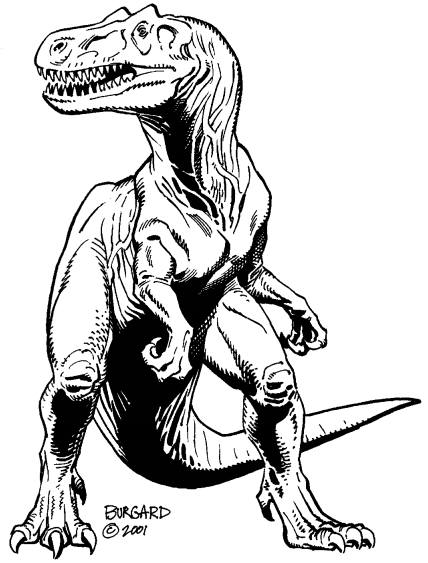
Allosaurus (CR 7)
Referred to as "sweet teeth" by the lay folk, Allosaurus are mostly treated in terms of how they differ from Tyrannosaurus . The most obvious thing is that they fall at diametric opposite ends of the alignment spectrum, with Allosaurus being typically Chaotic Good and Tyrannosaurus typically being Lawful Evil. Allos pretty much don't like to fight, only hunting when there is nothing to scavenge, and even then perform reverent honors to their dead prey. Another contrast is that while the big rexes tend to be more muted shades, the big Als tend to be bright shades of blue, red, and yellow.
Allosaurus Intelligence score is 9 standard, which means they are only barely less intelligent than your average human. They are somewhat willing to form bonds with Bronco Riders, will form non-aggression pacts with settlers in exchange for sustenance, and are generally pretty chill fellows. The only thing that will actively cause an Allosaurus to enter combat with the intent to cause pain and violence is if they face off against evil predators. The most likely scenario for one fighting player characters is the fact that, in spite of their genial nature, allos are popular safari hunt targets. You can sell their body parts and hides on the market for a decent price (though far less than a rex, of course), but why would you do that? You horrible, horrible person. It's like skinning the dinosaur equivalent of Gandhi.
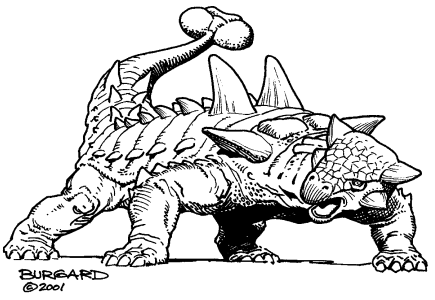
Ankylosaurus (CR 7)
Given the nicknames "wrecker" and "megadillo", the sturdy Ankylosaurus are basically an entire species of grumpy old people. They aren't particularly bright (Intelligence score is 6) or talkative, and would pretty much prefer to be left alone in their nomadic matriarchal bands that trod across the plains. Negotiating with these armored saurians is like talking to a brick wall, and as such they are almost never coerced into being used as mounts. Caravans like to use their armored hides as defensive suits for their own dinosaur mounts, though, which means that there is a market for actively stepping on the grumposaurs' figurative lawn.
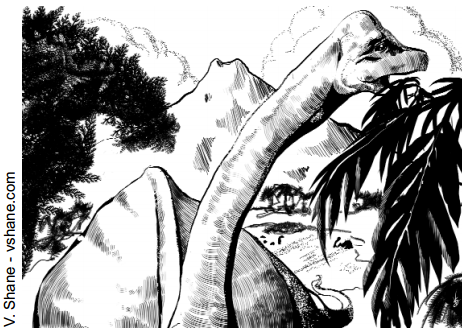
Brachiosaurus (CR 11)
You know the phrase "an elephant never forgets"? Brachs take that motto to a whole new level. These immense sauropods remember pretty much everything they've seen in their lifetimes, and are actually particularly fond of sharing gossip about mating rituals of the herbivores they've met (
 ) and telling stories of the dynasties of the great predators they have encountered. If they are around humans from a young age, they are pretty amiable to the idea of being immense beasts of burden, while wild adult specimens have more of a bemused attitude at the adorable little furless mammals that have come to their planet.
) and telling stories of the dynasties of the great predators they have encountered. If they are around humans from a young age, they are pretty amiable to the idea of being immense beasts of burden, while wild adult specimens have more of a bemused attitude at the adorable little furless mammals that have come to their planet.
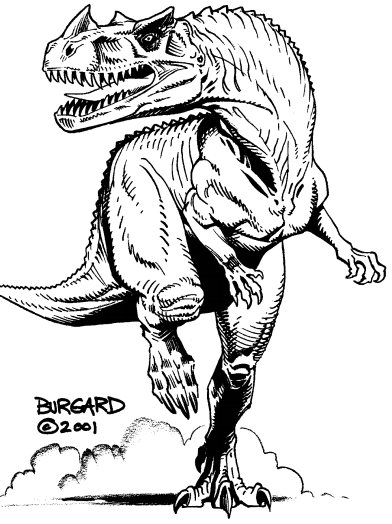
Ceratosaurus (CR 6)
Meet what are basically your saurian “CE mid-level mooks” for Broncosaurus Rex. Ceratosaurus are Chaotic Evil, deceptive, foul-tempered, and violent. Attempts to negotiate with them will inevitably lead to them taking your offer, then turning around and attacking you because they can. They are also obsessed over ambush points, scanning an area for any structure that can conceal 20 feet of theropod before waiting excitedly to get the jump on their target. As creatures that revel in carnage, it is probably of no surprise that the safari hunters willing to kill even Dino Gandhi will go after Ceratosaurus with gusto. It’s believed that their horns provide a powerful aphrodisiac, and they certainly do have a potent medicinal quality – if you grind one up and gulp it down, you get a temporary +1 bonus to Strength.
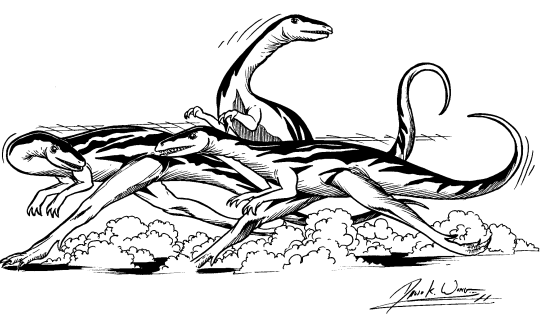
Compsognathus (CR ½)
Our first example of a dinosaur that has standard animal-level intellect rather than sapience, the swarming little predators the frontiersmen call “roadrunners” and “swarmies” can be found in large packs that chitter and chirp constantly as they flush insects out of the underbrush. They aren’t really that threatening with their minor bite attacks, though they have been known to attack humans from time to time if their packs get extremely large, and they don’t have any byproducts that make them targets for safari hunts or other such groups. Basically, the compies are your goblins for the setting, being thrown at first-level characters in groups to let them level up.
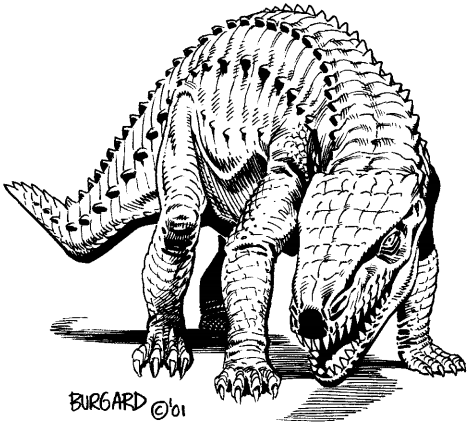
Crocodilian – Protosuchus (CR 1)
The small land-dwelling crocodilians nicknamed “diggercrocs” happen to be dog-sized, with fossil remains clocking them in at around 3 feet in length. Surprise, surprise, they happen to used as dog-like trail companions by a good number of Bronco Riders. In their natural habitat, Protosuchus are colonial creatures that you can find in pretty much any decently warm area that has good soil they can burrow into. In combat, they’re a lot like reptilian wolves, using diverting pack tactics and generally being pretty cool crocs overall.
Crocodilian – Deinosuchus (CR 6)
Don’t let that most likely under-guessed Challenge Rating fool you – Deinosuchus , the “megacroc”, is very dangerous. 40 feet long and capable of crushing down with 4d8 points of bite damage, this predatory powerhouse can outrun a human on land and damn well outswim one in the water. It is a solitary hunter that feeds on large dinosaurs and pretty much anything else it pleases, and even the tyrant kings tend not to really step on their turf. They also have military applications, believe it or not. While not stated in the core book, there is a short story supplement – listed as part of the “Grubbs Files”*, material written up by a fan rather than Goodman Games itself that has apparently been endorsed as at least pseudo-canon given its prominent placement in the Resources section of Broncosaurus Rex’s online supplements – that discusses the use of Deinosuchus in a fight against Union ironclad mechs. Basically, the plan consists of luring Ironclads into the swamps near Deinosuchus dens, riling up the boisterous reptiles, and then letting them come out wounded but victorious after they plow the Ironclads into the muddy bottoms.
*I’ll be looking over the Grubbs Files in full once we finish with the actual printed books, as they have some rather important supplemental things like faction feats for the factions other than the Confederacy. Feats that people other than the Confederates get to call their own?! Shocking, I know.
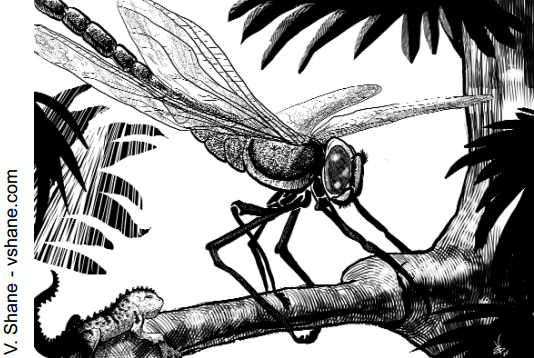
Dragonfly, Giant (CR 2)
The only creature of the Vermin type in this book, giant dragonflies are human-sized dragonflies that fly around swamps and generally act as really annoying adversaries. They don’t really fight so much as rip a hunk out of your flesh that is enough to fill their stomachs, then fly off until they get hungry again, at which point they will attack the nearest thing once more. Its probably likely that the player character will once again be that “nearest thing”, as I doubt many DMs would pass up the opportunity of letting these creatures repeatedly show up and attack before attempting to retreat yet again. These also aren’t the only monstrous vermin on Cretasus. No, we’ll meet more once we get to the adventure guide, I promise.
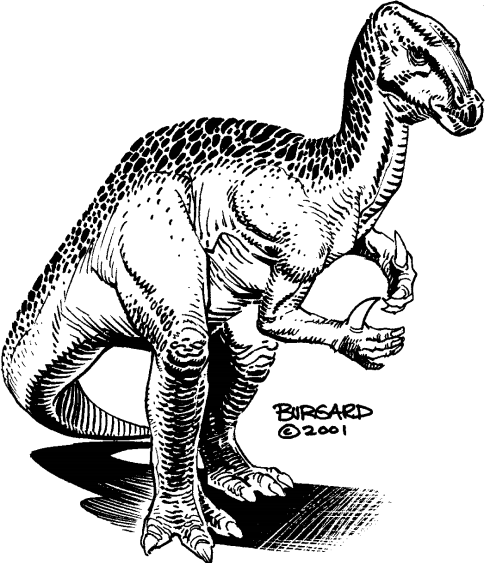
Iguanodontids – Camptosaurus (CR 2) and Iguanodon (CR 5)
Normally, I’d separate these double entries like I did above for Protosuchus and Deinosuchus , but there is no way I really could for these two. While they have different Challenge Ratings and sizes (the former is size Large, the latter is size Huge with the upped stats to match), the flavor text pretty much unanimously says everything about “iguanodontids” rather than giving any differentiating qualities to the two. Iguanodontids are stated to be rather enigmatic creatures – while they are talkative and eager to share what they’ve heard on the trails, they also just utterly disappear into unknown regions when it is time to breed. No one has ever actually seen an iguanodontid egg from either of the two species presented, nor have their courtship and breeding ever been documented. When they are still around, though, they are known for basically being sort of the dinosaur law enforcement. They are Lawful Neutral, after all, and they even form posses!
quote:
Iguanodontids facing repeated attacks from a difficult predator that isn’t much stronger than them (for example, a territorial ceratosaurus) will organize a “posse” of the most powerful adults from several herds. The posse will then drive out and possibly kill the predator. Most carnivorous dinosaurs prefer to hunt easier prey than iguanodons.
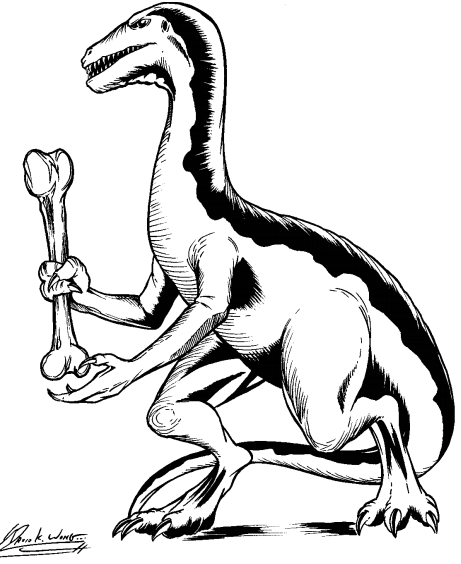
Ornitholestes (CR 1)
These dinosaurs have been given the nicknames “handy-hander” and “grabber”. Take a wild guess what low-level role they are designed to do.
Yes, that’s right, they’re the assholes that will steal your stuff. Anything they see that looks interesting will be taken, investigated, and then either thrown away somewhere in the wilderness or taken back to their tribe to share. They can also wield and learn to properly use clubs, knives, swords, and even things like bows and crossbows, so they are surprisingly dangerous for a rather average small theropod. As Ornitholestes aren’t really evil so much as prone to curiousity, some Bronco Riders take them on as traveling companions. Miners and ranchers tend to just up and shoot them on site, though, so it’s probably best to keep them close if you are one of those people that wants one as a trail buddy.
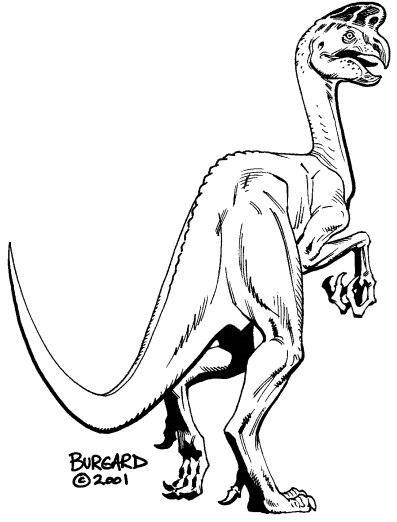
Oviraptor (CR 1)
Oviraptors are another one of the litany of very low Challenge Rating creatures provided for your heroes to encounter early on. They’re also pretty much the most boring, being mostly non-combative Chaotic Neutral creatures that travel in pairs and prefer to avoid combat. They are, however, noted to be sometimes trained as guards for human settlements, which could lead to at least a few interesting encounter ideas.
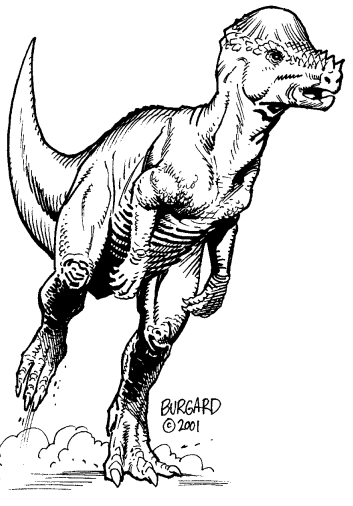
Pachycephalosaurs-Stegoceras (CR 3) and Pachycephalosaurus (CR 5)
Like the iguanodontids, the pachycephalosaurs are pretty much treated as unanimous, with the difference again being between a size Large and size Huge species. Pachycephalosaurs tend to be really obsessive about the concept of home, with herds staking out a big rock, cave, or stand of trees in the middle of open plains as “home base”. They are adamant about defending this home base and will fight pretty much anything that gets too close to their home. Pachys are some of the few creatures that aren’t actively sought out by humans – they are hard to stay on top of when they do their charging headbutts, and the only item of value inside of them is their skulls, which are relatively popular with collectors of eccentricities.
-----------------------------------
Next time: the rest of the bestiary, from Parasaurolophus to Velociraptor .
Bestiary Continued: Parasaurolophus to Stegosadness
Original SA post
Bestiary Continued: Parasaurolophus to Stegosadness
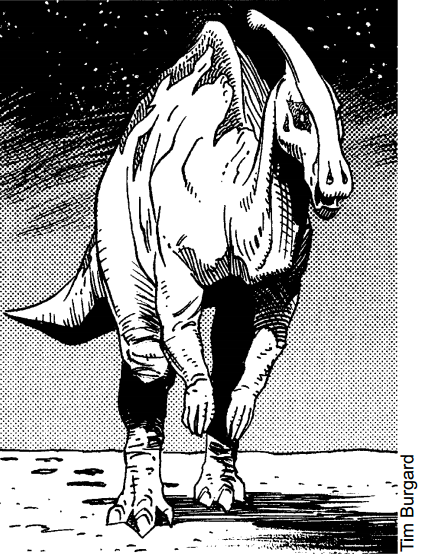
Parasaurolophus (CR 3)
Okay, let's just get the dino nerd rage out of our systems by quoting the worst parts of this entry first.
Broncosaurus Rex posted:
They spend at least half their time in the water, much like the modern hippopotamus. [...] Parasaurolophus can breathe through their skull crests. They like to relax just below the surface of the water with only the tip of their crest showing. Characters who encounter a few parasaurolophus along a riverbank may not realize two dozen more are sitting just offshore.

Other than this blindside of surprisingly old school thought on dinosaurs, the entry for poor pitiful Parasaurolophus just isn't of much circumstance. We learn that they are popular food for frontier folk in spite of the fact that they are somewhat dull but able to formulate language and understanding, are also popular amongst musicians for their crests, and are popular amongst hunters and travelers because of their ability to be used in groups as long distance communication.
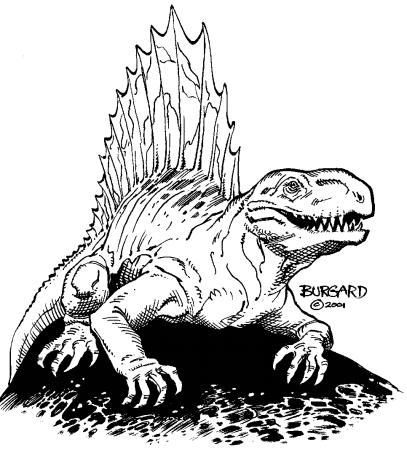
Pelycosaurs – Dimetrodon (CR 2) and Edaphosaurus (CR 1)
Dimetrodon is perhaps one of the most famous pre-dinosaur creatures I can think of, and it is of no real surprise that it appears in this title. Broncosaurus Rex presents them as opportunistic predators that travel in small packs, picking off the weak and wounded. It is apparently actually very popular for trophy hunters on Cretasus to kill one of these "sailwolves" with just a knife, cut off its sail, and have it as a conversation piece.
...You know, the more I reread this, the more I have the feeling that nearly everyone on the planet of Cretasus is a psychopath. At least Dimetrodon are standard animal intellect and not a sapient consumable.
If you don't want to wrestle one of these pugnacious pelycosaurs down and rip its sail off with your grandpappy's Bowie, you could also potentially train one. They are apparently popular as the reptilian equivalent of bird dogs if trained properly.
The far less imposing relative of Dimetrodon , the plodding "sailsheep" Edaphosaurus aren't known for much besides being decidedly boring and having really tasty eggs. Even the book's own text piles on the mockery of these poor saps:
Broncosaurus Rex posted:
Edaphosauruses can be trained as well... but why would you want to?
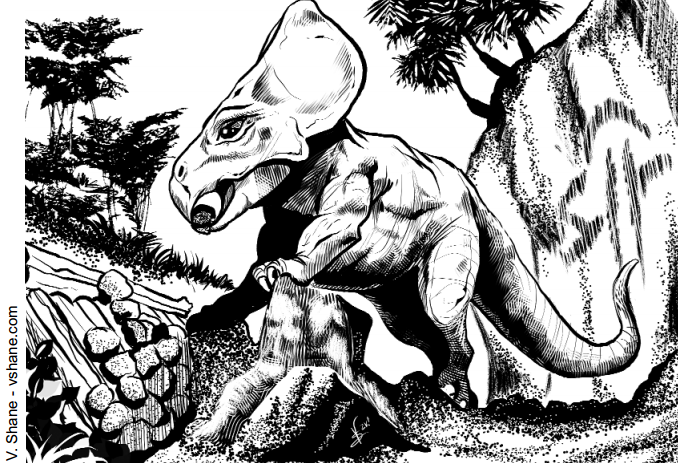
Protoceratops (CR 2)
This right here is where the id of James Gurney creeps into the setting by force. The Broncosaurus Rex Protoceratops are pretty much exactly like the Dinotopia Protoceratops : clever, linguistically capable, and renowned as diplomats and sages. I’d say more, but honestly I’d just be doing comparisons to another work, and pop culture confluence on that level was why I ended up avoiding the roleplaying game I had originally planned on reading through before I chose Broncosaurus Rex.
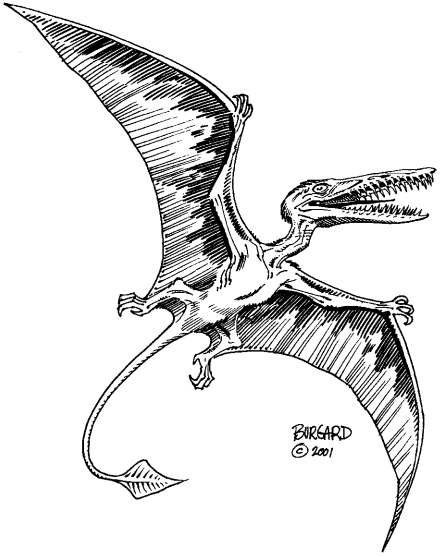
Pterosaurs – Pterodactylus (CR 1/2) and Pteranodon (CR 4)
This segment gives us a wee li’l pterosaur that is often trained as a falconer and one of the most iconic pterosaurs out there. It also gives us an illustration of Rhamphorhynchus , a pterosaur that isn’t even in this book. Good work! There’s not really much else to these brief entries, though.
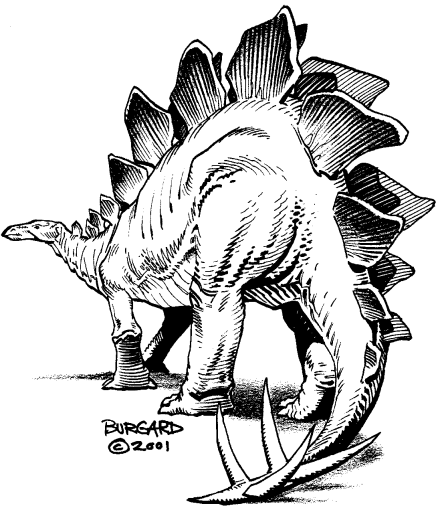
Stegosaurus (CR 7)
I think it might be best to let the book speak for itself on this one.
“Broncosaurus Rex” posted:
Stegosaurus has the dubious distinction of being one of the dumbest dinosaurs ever to walk the earth. For a beast over twenty feet long and weighing as much as three tons, its three-ounce brain gives it the smallest brain-to-body size ratio of any dinosaur. Nonetheless, it has enough brains to do what it needs to do, and its spiked tail ensures that other dinosaurs won’t tease it too much!
They follow up on this premise, too. Poor old steg has an Intelligence score of 1. 1 . The lowest number possible while still retaining brain autonomy. Even the blundering Edaphosaurus at least gets an Int score of 2! Furthermore, if we’re going with the premise of “brain to body ratio = intellect”, how the hell do we have things like the near-human intelligence Allosaurus ?

----------------------------------------
Next time: the saurian Big Three, and a discussion of [pseudo- Velociraptor and Tyrannosaurus supplementary information.
Bestiary Concluded: The Big Three
Original SA post
Let's Finish the Bestiary Chapter: The Big Three
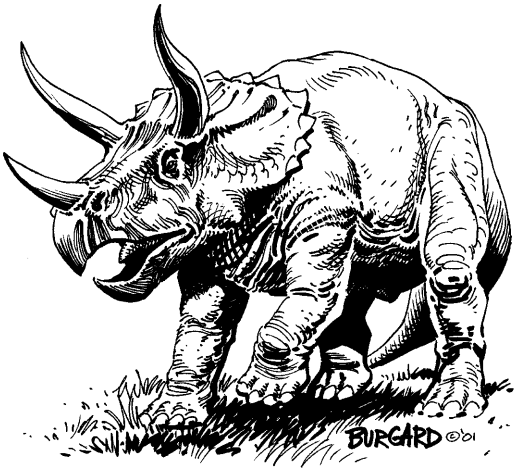
Triceratops (CR 7)
It could be argued that Triceratops is the most important dinosaur in Broncosaurus Rex. One of its lay nicknames, "bronco", makes up a prominent part of the title. Furthermore, humans in the setting love it for many reasons, too: Bronco Riders for its strength and determination as a mount, ranchers for trike profitability as new cow for a new generation, Confederates for the strategic use of wild trike stampedes to break apart tightly-knit Union armored divisons, settlers for its rich and plentiful meat, and trophy hunters for the magnificent skull the creature has. This brings up the whole awkward nature of using a sapient creature (Intelligence 6 for trikes, same as an ogre in D&D) as both beasts of burden and food once more, of course, but it never really left throughout the bestiary.
When left to their own devices, these mighty three-horned dinos live in mass herds that thunder across the plains, forming annual migration routes and a strict heirarchy. Any foreign Triceratops that wishes to join a new herd must undergo weeks of scrutiny before being accepted or rejected. Elders are to be respected and youth defended, and any inter-herd squabbles are done with non-wounding shoves and posturing. Even in combat, a trike will prefer to bluff and mock charge, having little desire to actual physical violence. Are you feeling bad for eating them en masse yet?
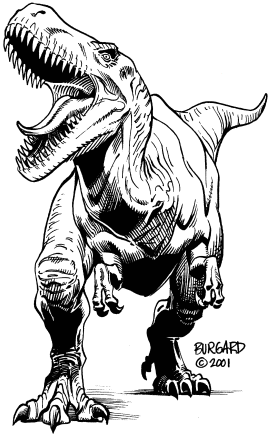
Tyrannosaurus (CR 8)
Tyrannosaurus rex : "tyrant lizard king". Broncosaurus Rex very much focuses on the "tyrant" part of that name, as rexes are Lawful Evil creatures obsessed with dynasties and extremely close family relations. Outside of their family, though, don't expect much hospitality. Rexes are known for holding generations-long grudges between warring clans and with other species, and they don't forget or forgive easily. They're huge speciesist assholes, treating anything other than rexes as inferiors, and have a fondness for figuring out good ways to torture captives and bully smaller creatures. Confederate Bronco Riders have somehow managed to at least get some rexes to help them in the fight against the Union, though.
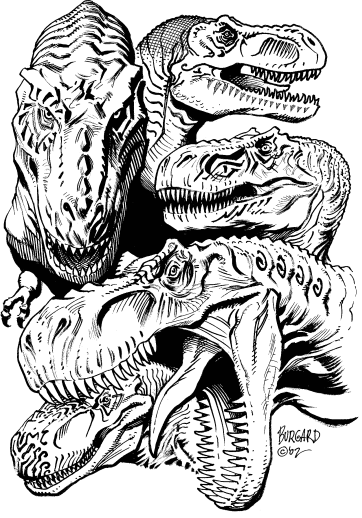
Pictured: Tyrant kings
It is also here that I should probably go over one of the smaller pseudo-supplements that have tenuous ties to Broncosaurus Rex proper: namely, the Complete Guide to Tyrannosaurs. This setting-neutral guide was part of Goodman Games' "complete creatures" line, but does have some tidbits on Broncosaurus Rex Tyrannosaurus , so it would be unfair of me to gloss that over. So, what do we learn about Big T on Cretasus from its complete guide? For one, they are psychic . The oldest and wisest of the rexes, the CR 18 tyrant kings and CR 22 tyrant masters, have immense mental power that they can channel into psionic abilities. At least one ancient tyrant master is behind the mysterious phenomena of the Haunted Woods, a region we'll see once we get to the adventure guide. The lesson to take away from all of this is simple: don't fuck with rexes.
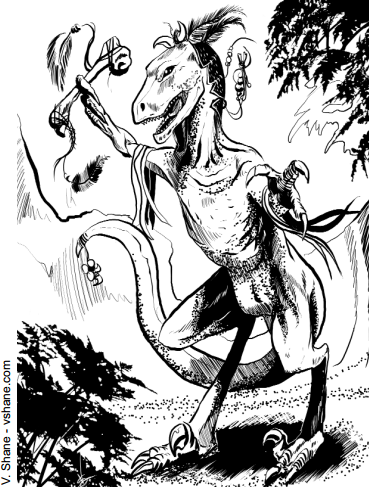
Velociraptor (CR 3)
Time to start off an entry with the book's own words again!
Broncosaurus Rex posted:
Paleontological confession: Velociraptor and deinonychus are actually two different dinosaurs, with velociraptors being the smaller of the two. However, since a certain hit dinosaur movie has popularized velociraptors that look like deinonychus, we will perpetuate the popular confusion of the two, and call the deinonychus by the name velociraptor. Thus, the stats above are those for a deinonychus, which in this work we call a velociraptor.
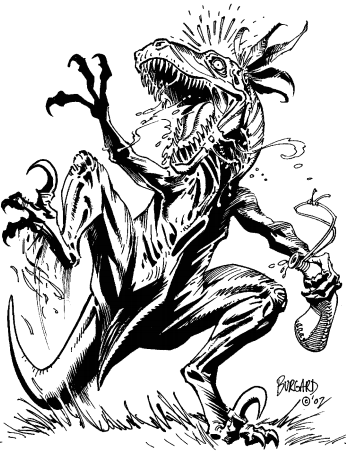
"Drunk on the battlefield ain't no way to be, son."
As with rexes, the raptors got their own spotlight title with Complete Guide to Velociraptors, and it had just as much supplemental information for Broncosaurus Rex as its rexy kin did. What would probably be most important for a DM would be the information on the major raptor nations of the planet Cretasus: the "never surrender!" Cree, the stone structure-building Lettoko, the plains-runnng Grapt, the mercentile Whimbit, the bloodthirsty Kerosaw, the stealthy forest-dwelling Flage, the enigmatic Crado of the Black Jungle, the judicial and fair-minded Inaka, and the snake-worshiping Listh. This book also has those "raptors as player character" rules that are so enticing, including three raptor-specific core classes: Shaman, Tactician, and Warrior. The Shaman class gets the ability to make explosives and poisons, the Tactician gets the Soldier class's tactical feats as well as the ability to choose some raptor-specific stealth feats, and the Warrior is basically a raptor-specific Fighter.
---------------------------------------
Next time: the Gamemastering chapter!

Chapter 4: That Prerequisite Gamemastering Section
Original SA post
Chapter 4: That Prerequisite Gamemastering Section
After our trek across the bestiary entries from the humblest of creatures to the finality of the Big Three, we have reached Chapter 4: Adventures on Cretasus. This, our final chapter of the first book in the Broncosaurus Rex series, is the prerequisite chapter on just what a gamemaster should generally know. A lot of things presented here will be expanded on when we get to the next book, but I'm going to go over them anyway.
Factions
To start off this final chapter, Broncosaurus Rex gives us a look at factions. While some, such as the Union and Confederacy, were obviously covered during character creation, it is best to note the further additions given a feature here.
-
Settlers:
The overarching category of the "everyperson". Settlers are everybody from farmer Bob and his old homestead to the owners of wide-spanning
Triceratops
ranches. There are also some non-military villains to be had through the settlers, in the form of robber-barons, outlaws, and nondescript but apparently present cultists.
-
The Cabal:
Meet the ace in the hole for allowing characters to be part of the Union but not evil. You see, it isn't actually the Union itself that is the villain: no, it's just that their actions are guided by an Illuminati-like group called the Cabal. The police states, slave labor, strip mining, and military-industrial complex of the Union are all the result of the Cabal. What's the end goal? To take over the worlds, of course!
- The Dinozonians: Space Amazons. The Dinozonians were formed by a settler who found herself respect amongst the raptors and started the tradition of this group of all-women Wild Ones who defend the territory of their totem dinosaurs.
And...that's about it, really. There are some little treasure tables and the like at the end, but that is pretty much all there is to the gamemastery section. If you want actual gamemastery, you'll have to wait until next time, when we cover the second book of the series.
Cretasus Adventure Guide: Georgia Pride
Original SA post
I'm almost hesitant to call the Cretasus Adventure Guide a sourcebook, even if the actual publishers call it that. Pretty much everything from the world map up as far as gamemastering goes is found in this book. This is the title that gives us a lot of information that was just teased at in the actual core book: the Main Valley of Cretasus, Union ironclad mechs, and the setting's major extraterrestrial species, amongst other things. It also teases at things that will never actually be revealed, such as the mammal-filled Mammoth Valley to the north, but c'est la vie.
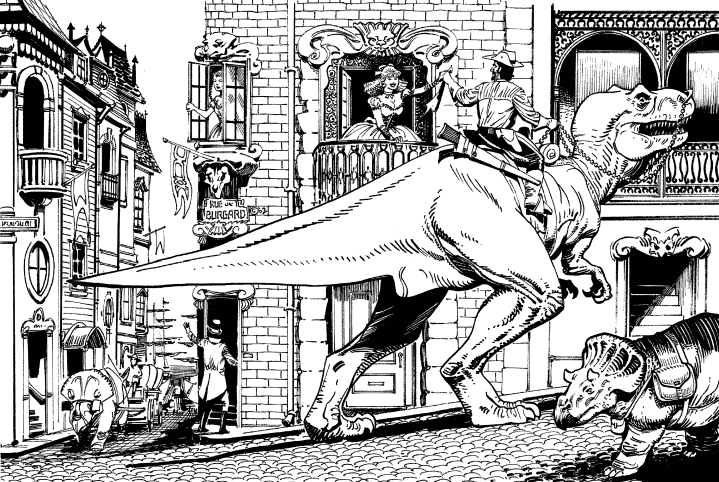
New Savannah - not a lot different from old Savannah.
Chapter 1, Part 1: Georgia Pride
New Savannah
After a page-long introduction that is more or less a rehashing of what we already know, the book throws us headfirst into the layout of the Main Valley. The first stop on our journey is New Savannah. This is the largest human settlement on Cretasus, and was founded by these guys:
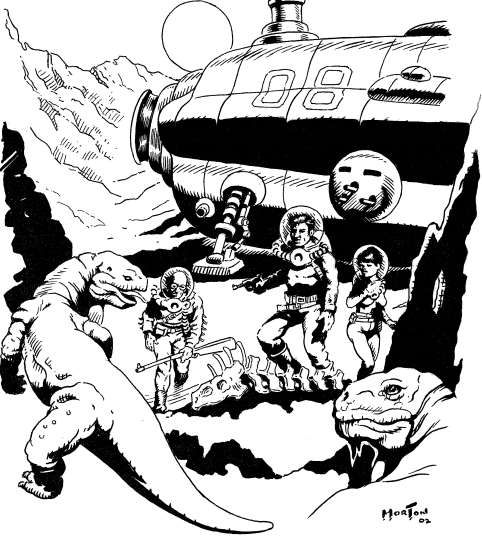
The latest in Buck Rogers fashion design!
Meet Hepsediah Porter and company. A Georgia tycoon with "a devout sense of fair play", Hepsediah loaded up his family on a trip to space after his wife died. They managed to find Cretasus and, through hard work and perseverence, managed to form the palisade-enforced beginnings of the city of New Savannah on the edge of the Main Valley's inland sea. I doubt the Triceratops and Albertosaurus they pushed out to make it really appreciated it, but it's not like dinosaurs are sapient and could theoretically have land rights! ...Oh, wait.
The government of New Savannah is a lot like the old south sans the slavery, being governed by the Porter family and friends, dominated by the gentry, and filled with lots of sheriffs and soldiers wearing gray uniforms. It's a pretty good city if you're a Confederate human, but not so much if you're an extraterrestrial (quarantines and strict immigration laws are not your friend) or a dinosaur (which means you will be on a leash at best and under military watch or fitted with a shock collar at worst). Information is given out for most of the general areas of the city, from low-profile places like Uncle Moe's diner all the way to the the Office of Civil Defense's milita barracks and the explorer's guild-like Confederate Planets Center for Knowledge. There are also our first actual honest to god NPCs. In addition to some generic human NPCs like militiamen, there are also three named NPCs. While I won't be going over every NPC the book has, I will make an exception for these first tree as a general example of the kind of people you'll be meeting in this game.
-
qrfel (Protoceratops Spy 5):
qrfel comes from the Underglen, a clan of protos that think all lower-case names are somehow less pretentious and arrogant than capitalizing them, and actively works against the Confederacy. This sneaky saurian gathers intel to hand off to anti-settler groups like larger raptor tribes and groups of Wild Ones, sells guns to raptors, and is generally a thorn in the side of the Confederates' attempts to "tame" the dinosaur planet.
-
Zagmo (Ornitholestes Fighter 1/Rogue 2):
An
Ornitholested
Fighter 1/Rogue 2 who acts as the sticky manipulating fingers of qrfel's outfit. He is a dinosaur that wields a laser sword, and that is all that you should need to know as to why he is a great character.
- Richard Montague (Offworlder Human Two-Fister 3): Part of the Louisiana gentry yet somehow classed as being an Offworlder, Richard Montague is obsessed with new knowledge about Cretasus, and especially about any new developments in the big bayous of the Main Valley.
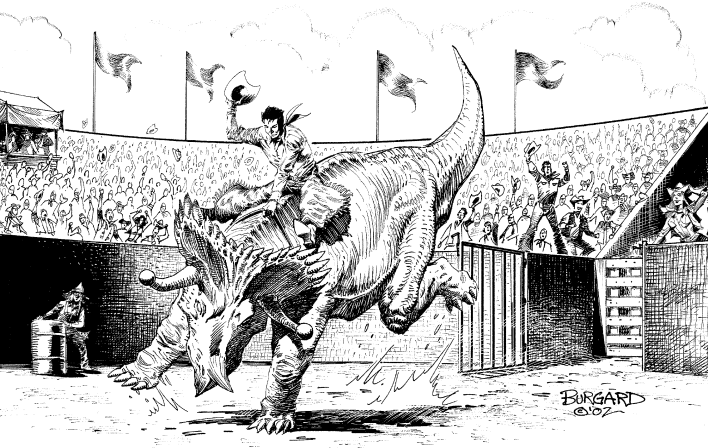
Mount Crowe
Mount Crowe is a mining town that sprouted off from New Savannah, and is run by the iron-fisted Confederate colonel Paul Decker. The town is mostly overrun with steel mills and iron mines that rip into the Pteranodon -infested mountains and fuel the needs of the Confederacy that can't be solved with plantations and bootstraps. If you are of a less industrious sort, there are certainly other parts of town such as Kitty's dance house and brothel or Big Al's Dino Rodeo. You could also have a drink with William Levers, a drunken old Confederate war veteran (who is somehow only a first level Warrior) who tells many tall tales. According to Levers, the owner of Kitty's is a Union spy, the local loggers are lead by a Union spy, the steel mines have Union spies, and pretty much every organization that exists has at least a few Union spies. While he may not be reliable, Levers does fulfill the very important role of "that quest-giving guy in the tavern".
The Dukes and Butlers
While these two families are given about five pages, I can sum them up in three words: Hatfields and McCoys. The two big-name families have been feuding since the founding of the original Earth city of Savannah, and their latest generation has staked out two competing ranch companies on Cretasus. From hiring rustlers to leading large theropods into rival herds, the two families are at the same time close, in that they need one another to fuel the hatred that drives their ambitions.
The McQuarry Brothers and the Hideout Hills
Kane and Abel (
 ) McQuarry are two brothers that have become infamous for avoiding the law thanks to a premonitory psychic link between the two even they don't understand. While they and their history spread across a few pages, they are mostly present to lead into the next region near New Savannah: the Hideous Hills. If you couldn't guess from their name, the Hideout Hills are rife with criminals, running from small tag-teams lik the McQuarries up to the infamous
) McQuarry are two brothers that have become infamous for avoiding the law thanks to a premonitory psychic link between the two even they don't understand. While they and their history spread across a few pages, they are mostly present to lead into the next region near New Savannah: the Hideous Hills. If you couldn't guess from their name, the Hideout Hills are rife with criminals, running from small tag-teams lik the McQuarries up to the infamous
The Great Library of Logos
An important part of the lore of the Protoceratops , the library of Logos was the repository of the species' collected intelligence and learning. It has since been lost to time thanks to a streak of disasters that spelled doom for the great library little scholars. The first disaster was when the savage barbarians of the desert, the Leptoceratops , cast their greedy eyes on Logos and raided it with fury. Then, like a replay of the legendary Atlantis, a great flood swallowed both the invading barbarians and the library whole. The great library supposedly still remains at the bottom of the large Danjow River, which means that a large period of the Protoceratops history has been lost. This has caused great grief in the species, as well as great opportunities for any adventurers that want to travel into the region.
The Crystal Desert
The home of the barbaric Leptoceratops , the Crystal Desert is a land of sweltering heat and mysterious glass and crystal formations in an otherwise moist and verdant region of the Main Valley. Why is it this way? Because aliens, that's why.
Cretasus Adventure Guide, pg. 33 posted:
Resting beneath the shards of glass and clumped sand is the battered shell of a crashed alien spaceship. Its crash landing and the resulting reactor meltdown long ago changed the desert’s very nature. The rubble at the crater bottom is the only clue to the hull buried beneath. It has been empty for at least 10,000 years, for even the protoceratops’ great library, which contained 10,000 years of accumulated knowledge, described it as an aging, empty wreck.
Also, is it just me, or is "Crystal Desert" a term used in a lot of sci-fi and fantasy works? Even I've used it on occasion.
-----------------------------------
Next time: down the Tecumseh Trail.
Forts Save
Original SA post
Chapter 1, Part 2: Forts Save
The Tecumseh Trail region encompasses most of the central Main Valley, from the namesake fort west of New Savannah to the immense bayou that is simply known as "the Bayou".
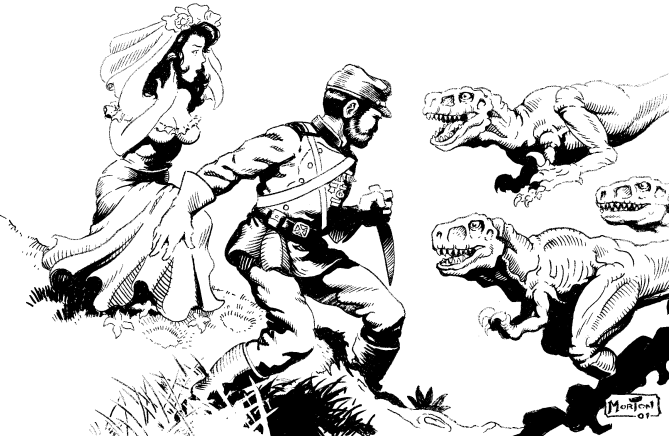
Fort Tecumseh
Fort Tecumseh is the major military fortification of the Confederacy on Cretasus, having been formed only four years after New Savannah by General [First Name Unknown] Bowie. Bowie is known for being
 as fuck, having whipped together an army from across hundreds of planets and stabbed a raptor to death with a cake knife when its pack raided a wedding party. He's also known for being more of a practical sort than the gentry of New Savannah, placing fortifications in locations that are prime for westward expansion and treating everyone with a commander-to-soldier dynamic rather than playing favorites based on who has what fancy parentage. Fort Tecumseh has a population of about 10,000, with 2,000 Confederate soldiers, 500 civilians within the fort proper, and the rest of the population being found in scattered farms, ranches, shops, saloons, and brothels that have cropped up directly around the fort. The most famous parts of the military population are the Dino Warriors, the elite Confederate Bronco Riders that are attempting to raise dinosaurs and ship them offworld to fight the Union on other contested planets as well as Cretasus.
as fuck, having whipped together an army from across hundreds of planets and stabbed a raptor to death with a cake knife when its pack raided a wedding party. He's also known for being more of a practical sort than the gentry of New Savannah, placing fortifications in locations that are prime for westward expansion and treating everyone with a commander-to-soldier dynamic rather than playing favorites based on who has what fancy parentage. Fort Tecumseh has a population of about 10,000, with 2,000 Confederate soldiers, 500 civilians within the fort proper, and the rest of the population being found in scattered farms, ranches, shops, saloons, and brothels that have cropped up directly around the fort. The most famous parts of the military population are the Dino Warriors, the elite Confederate Bronco Riders that are attempting to raise dinosaurs and ship them offworld to fight the Union on other contested planets as well as Cretasus.
Fort Lincoln
If you head southward from Fort Tecumseh and across the Hampshire Mountain Range, you'll find Fort Lincoln. Fort Lincoln is a powerful structure of stone and steel that acts as the home base for the Union on Cretasus, as they have no cities or towns of their own to compare to New Savannah. Its technological prowess far outshines the Confederates' outposts, with ironclad mechs, motorcycles, and jeeps all being fairly common sights, but its population is decidedly smaller. After all, why would a government-sponsored Union attempt to gain a foothold on the planet have a strong population? They don't have the Confederate power of bootstraps and folksy wisdom!
Cretasus Adventure Guide posted:
But the lead is rapidly narrowed by the Union colonists’ inexperience with rural living. Most come from the sprawling Union super-cities and have no idea how to farm, ranch, fish, or hunt. That’s why Fort Lincoln is often filled with colonists returning from the back country – their farms failed or their livestock died, and now they need more training or more supplies. Because of this, Union colonists make up a disproportionate number of the loggers and miners on Cretasus, as both those vocations are easy to learn and they produce profits fast.
Cretasus Adventure Guide posted:
They are an example of Union industrialism at its best – and worst. While most Confederate mines use human and animal labor to mine the earth stone by stone, the Hampshire Mines use heavy equipment to raze the ground, dig deep pits, and send up massive amounts of earth which are sifted above ground. The miners spend less time swinging picks and more time operating machinery. Unfortunately, this process utterly destroys the natural landscape, and the mine operator, Ford Windham, is merciless. The wasted terrain at the Hampshire mines has incited the wrath of every intelligent dinosaur in the land, as well as numerous wild ones, and the mines must deal with regular attempts at sabotage by human and dinosaur alike
The Southwestern Plains
Leaving the awkward juxtaposition of factions behind, we find ourselves in the southwestern plains of Cretasus. This region acts as sort of an overflow of the traffic coming on the Tecumseh Trail, with many small towns and ranches having cropped up on the rolling plains and the forests that dot its edges. One of the most important organizations in these frontier towns is the union (not to be confused with the capital U union, of course) named the Association for Mutual Protection, based out of the logging town of Garsville. The AMP acts as a collective of watchmen and warriors that defend the frontier towns and ranches from threats such as dinosaurs and bandits. Not all is well with the group, however, as it has started to become criticized for the fact that it doesn't go out of its way to protect ranches that haven't signed up as official union members.
The Black Jungle
South of Garsville lies the Black Jungle. As its name implies, it is in perpetual shadow from the immense trees that choke the region. It is a region where only a handful of logging companies tread, mostly due to the strange phenomena related to the region. The Black Jungle is strangely dead - dinosaurs avoid it, insects are always silent, and reports of strange noises and ghost lights are common. While it's not stated in this book what the deal with the Black Jungle is, the Complete Guide to Tyrannosaurs revealed that the creepy paranormal events surrounding the jungle is because of an insanely ancient tyrant master and his psychic powers.
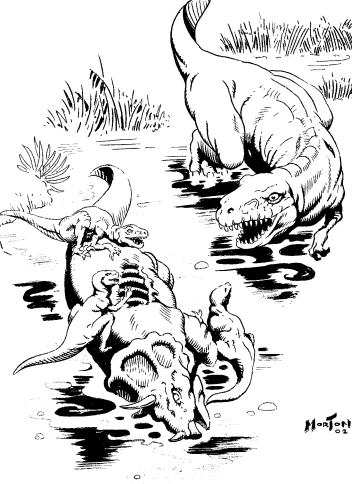
The Bayou
One of the most mysterious regions of the Main Valley is definitely the Bayou. Not having the luxury of having some of its secrets divulged in a "complete creatures guide" like the Black Jungle did, the Bayou is a strange and dangerous swamp of enormous size that divides the northwest and southwest portion of the valley. In addition to five Tyrannosaurus rex families and three raptor nations, the Bayou is home to numerous strange predatory amphibians and fish that aren't seen elsewhere int he valley, as well as a certain infamous sail-backed dinosaur that we'll be meeting in the adventure guide's bestiary. Human attempts to colonize the Bayou in the form of rice farms and boat channels have all failed, and only explorers and hunters that are in search of rare plants, trophy animals, or new discoveries enter the swamp.
------------------------------------------------------------
Next time: the Bay Trail region, the third out of the four regions in the gazette chapter.
A Pirate's Life
Original SA postHumbug Scoolbus posted:
He also wrote Nightbane and Armageddon. Actually he created the Unisystem Ruleset for Eden Studios. Speaking of Eden Studios, Terra Primate may sound goofy and awful, but it is actually really solid. All their games are.
But that's a story for another time. We still have Broncosaurus Rex books to deal with right now.

Chapter 1, Part 3: A Pirate's Life
Circling around the eastern edge of the Main Valley’s inland sea, the Bay Trail is basically where some pirates vs. ships of the line action is stuffed in on top of everything else. After all, we already have the Civil War, dinosaurs, steampunk mecha, and psychic powers, why not put in some piratical action?
The Inland Sea and the Bay Side Company
The huge inland sea that forms the centerpiece of the Main Valley is the only sea on the planet of Cretasus as far as any human explorers know, so it gets the very esteemed title of the Inland Sea. It’s dominated by wooden galleons and paddleboats thanks to no one on Cretasus seeming to think that building metal seaborne vessels is a good idea. Most of these ships belong to the Bay Side Company, a collective of free market-loving merchant captains that happen to fly under the same banner out of a sort of weird laissez faire love-in. The company does most of the wheeling and dealing that goes by water, but have aspirations to spread onto the land trade routes as well.
The Underglen
You may recall the Underglen being mentioned way back when the book went on about New Savannah. This Protoceratops city is carved into a ravine somewhere deep in the jungles that fringe the Bay Trail, and is well known for two things: having that stupid “we won’t capitalize our names, as that is too pretentious” clan naming convention and being very hard to find. Underglenners don’t particularly like company but are beholden to Protoceratops etiquette, meaning that they will be all passive-aggressive to any human that blunders in.
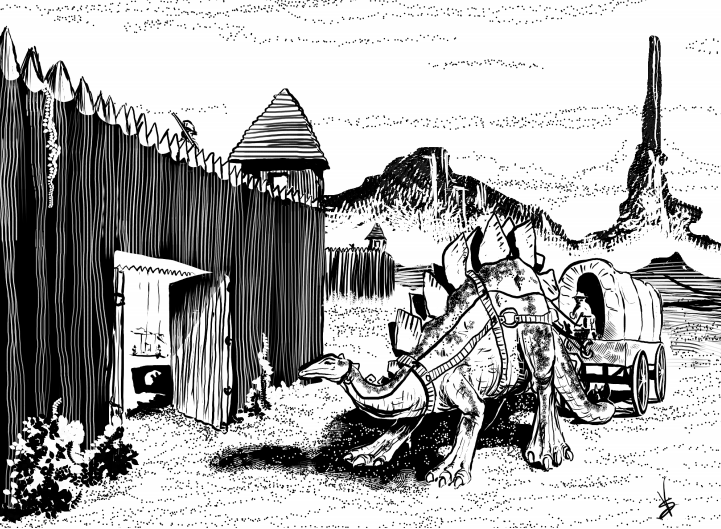
Fort Apache
Apparently actually older than the much fawned-over Fort Tecumseh, Fort Apache acts as the eastern guard for New Savannah and the gateway to the Bay Trail. It’s a rather sleepy fort after most of the dangerous local dinosaurs were either driven off or subjugated, and mostly deals in minor matters such as petty bandits and the like. The outskirts of the fort also has a collection of tepees that house raptors that have Uncle Tom’d their way into human civilization.
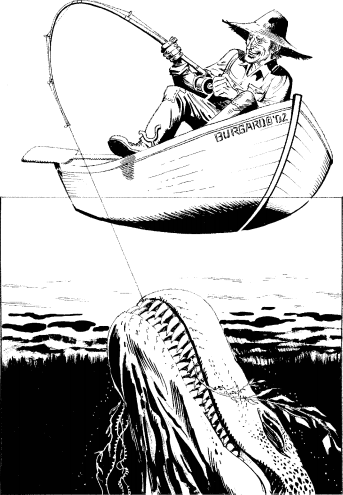
Plesiosaur Bay
The town of Plesiosaur Bay is the hub of pirates, brewers, and rough-and-tumble types. It’s very much almost a parody of the types of bar-fighting boomtowns you see in 1950s westerns, with statements about how Plesiosaur Bay’s citizens don’t shy away from murder but treat cheating at poker as a capital offense worthy of the death penalty. The waters of Plesiosaur Bay aren’t much friendlier than the town itself, as the thermal vents in its depths attract all sorts of primal fish and marine reptiles into the bay. These range from the relatively inoffensive and seal-like Plesiosaurus up the boat-crushing Kronosaurus , referred to as the “sea rex” by the locals. We’ll get to those in more detail once we hit the bestiary.
Northwestern Plains
The Northwestern Plains are the mystery spot of Cretasus. The unstated Pleistocene lifeforms from Mammoth Valley spill into the Northwestern Plains, as do dinosaurs that are stated to be as of yet undiscovered by the Confederate explorers. There are supposedly huge veins of silver and an old mansion build by the one tycoon who dared to enter the Northwestern Plains only to disappear, and starship pirates known as the warp pirates are said to hold their base of operations on Cretasus in these plains. Basically, this is another piece of sourcebook bait that was never followed up on when the setting died.
Everything you wanted to know about dinosaurs but were afraid to ask
Original SA post
I added the Northwestern Plains section of the gazette chapter to my last post, as I forgot that it was just one piddly page long. This means that we get to move on to discussing the second chapter

Chapter 2, Part 1: Everything you wanted to know about dinosaurs but were afraid to ask
Chapter 2 of the Cretasus Adventure Guide is what some of you may be truly excited for. It's a long expose on various aspects of the dinosaurs of the setting, including culture, mysteries, and the like. I'll be going over each of the segments of this chapter by header, giving a brief overview of the choice tidbits inside.
Dinosaur Intelligence
Why are dinosaurs on Cretasus capable of sapience? Nobody knows. That's pretty much the sum of the page or so that this section goes on for. It seems that there are at least some BR-verse characters that subscribe to the Tsoukalos Method - "blame it on the aliens". None of the alien species that humanity has encountered so far has owned up to having populated a planet with sometimes mentally-enhanced prehistoric creatures, though, so the case is unsolved.

Dinosaur Language
Long story short: most dinosaurs have some species-specific language, all of which have subsonic sounds that mean humans cannot replicate dinosaur speech unaided. There's also the generic language of Dinosaur Common, which gets this rather scathing line written about it:
Cretasus Adventure Guide posted:
All dinosaurs, even the imbecile stegosaurs, can understand the language of Dinosaur Common, which is conveyed by postures and movements as well as by sound.
Dinosaur Tools
Can dinosaurs utilize tools? Survey says yes. Raptors have their potions and weapons, Ornitholestes their bone clubs, Protoceratops all sorts of scholastic and agricultural materials, and big theropods are fond of making jerky with carcasses. All human factions fear raptors getting their claws on firearms, as they have shown some proficiency with rifles and pistols and a whole raptor nation with lax gun control could be unpleasant for the species that came from the stars to steal their land.
Dinosaur Singers
Dinosaurs have a sacred rite of "the Song", wherein they basically act the part of a Bard. One dinosaur doesn't get the fortune of being a Singer, though:
Cretasus Adventure Guide posted:
Dinosaurs of all size and temperaments Sing, except for stegosaurs, who are tone-deaf.
One particular Song is the Thunder and the Dark, a tyrannosaurid ballad that speaks of a great cataclysm that brought horrendous noise followed by darkness and death. Most believe it's a reference to an asteroid impact, either somewhere on Cretasus or as a folk memory of the Chicxulub impact held by space-traveling tyrannosaurs. Just as memorable is the Thrum, a Song that drives dinosaurs, marine reptiles, pterosaurs, and "dinopathic" humans into a frenzied rage towards a specific target.
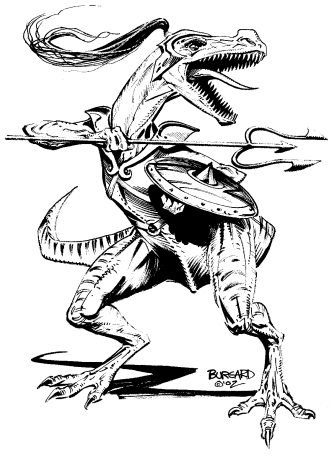
Cultural Habits
This segment details a specific cultural trait of five different dinosaurs as follows.
-
Thunder Moon:
The annual nocturnal
Ankylosaurus
mating ritual, which involves painting each other with mud, rhythmically stomping, and then going berserk and wrecking the environment around them.
-
Dancing With Oviraptors:
Oviraptor socialization involves a lot of dancing. Some fools think it is a good idea to corral these sharp-beaked predators onto human dance floors to boogie, but they are prone to attacking people that accidentally mime pieces of a mating dance and then fail to follow up with the right steps.
-
Raptor Kidnappings:
If a human is considered to be a particularly brave warrior and dies in combat with a raptor tribe, the raptors will take in a young child that family has to raise as their own. This is both a convenient backstory for Wild One characters and a way to make you stand out as one of the most
 party members possible.
party members possible.
-
Ornitholestes in the Ring:
There exist Free Fleet- and bandit-sponsored
Ornitholestes
gladiatorial rings that exploit the small theropods' natural love for combat and ability to utilize melee weaponry. Both the Union and Confederacy have criminalized the practice, but the dinosaurs' own love for fame and glory allows the rings to continue to thrive. One of the non-Roman weapons said to be popular in such matches is the chainsaw, which is certainly rather awkward given that no Broncosaurus Rex books have chainsaw stats.
- The Protoceratops Conclave: Wherein the nerdosaurs have a big get-together in their libraries.
Dinosaurs in the Wild
I could almost just skip this segment with a statement of "read basic human-animal interaction papers and you'll get the gist", but there's a steg-bashing quote that I can't pass up:
Cretasus Adventure Guide posted:
However, dinosaurs also talk amongst themselves, so even the dimmest stegosaur in the Main Valley knows about the flesh-lumps that have powerful weapons.
Raptors at War
If you couldn't guess, raptors scare the piss out of humans. They are the only dinosaurs immune to the Thrum, they are exceedingly clever, they are patient, and they are relentless. Even an ironclad won't truly stop them, as they'll just wait you out and attack the moment you need to get out of your precious metal suit. The book has already gone over how dangerous and badass raptors are multiple times, though, so I have no idea why they figured they needed yet another section.
-----------------------------------------
Coming in the overview of part 2: Economics lessons and dinosaurs as weapons of war.
Long Dino-Pig
Original SA post
Well, it certainly seems that we have a strong majority for Golden Age. So it was written, so shall it be. I'll probably do both it and Conspiracy X back to back, then see where the road leads after that.
For now, though, we still have work to do on the dinosaur planet.

Chapter 2, Part 2: Long Dino-Pig
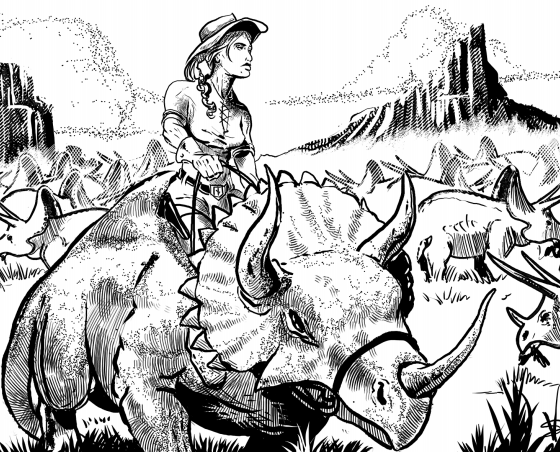
Dinosaur Ranching and the Range Wars
This. This right here is perhaps the most horrifying piece of fluff without even trying to go for horror. It’s a very manner-of-fact look at how dinosaurs such as
Camptosaurus
and
Triceratops
are ranched very much in the same way as cattle, herded across the plains, sent to slaughterhouse, and savored as one of the most popular meats for humans. This alone isn’t horrific, but the connotations within the setting make it terrifying. As I stated back when we were looking at the core book’s bestiary, trikes have an Intelligence score of 6. 3 is the absolute minimum for a creature to be considered sapient and capable of intelligent communication, and the three-horns beat that by three points – the same Intelligence score as ogres in Dungeons and Dragons. The whole “cattle ranching, but with dinosaurs” analogy falls apart when you realize that the dinosaurs are intelligent enough to form civilization. There’s this air of “they’re huge elephantine scaly things on four legs, so it’s okay to eat them”, and the thought creeps the hell out of me.
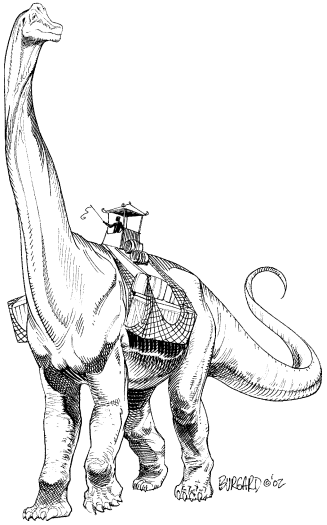
Dinosaur Labor
In spite of the title potentially gearing you up for a case of “second verse, same as the first”, this segment of the chapter is thankfully more forgiving than Dinosaur Ranching and the Range Wars. Dinosaur laborers (almost always sauropods) do get compensated for their trouble in the form of food and health care, and they typically have a close working relationship with their human partner. Some of the most famous sauropod-human working teams are the brachy-peddlers. A brachy-peddler is a traveling salesman of a classy sort, loading up a
Brachiosaurus
with exotic goods and traveling from town to town to sell them. The brach is pretty much the best insurance for the peddler – just as predatory dinosaurs are unwilling to attack these mountains of muscle, humans know that the close bond between the brach and peddler means that a missing peddler equates to a town razed to the ground by an angry sauropod.
Cooking Dinosaurs
Of course. Of course they'd have a specific subsection on this.

Cretasus Adventure Guide posted:
Munchasaurus is the premier offworld restaurant specializing in dinosaur meat. Their Brontoburgers, BrachLTs, and Igunanochomps (little bite-sized nuggets for the kiddies) are popular quick eats in every human city. Munchasaurus has seen meteoric growth in the last five years. Contrary to popular opinion, they do use 100% dinosaur meat in their meals, which means a lot of shipping.
Dinosaur Smuggling
Because humans are one of most frightening species in the galaxy, it's unsurprising that smuggling dinosaurs off of Cretasus is also a thing. Most dinosaurs that are smuggled are either small specimens to be household pets or mighty theropods to fight in underground arenas. The two most famous smuggling groups are the Red Claws and the Dons - the Dons are humanocentric stereotypical mafiosos, while the Red Claws are gun runners that have been supplying aid to the raptor nations.
Oh, and before we leave this section, we might as well have a quote about the differences between the Confederacy and the Union! Those are always fun.
Cretasus Adventure Guide posted:
Taking live dinosaurs offplanet is illegal, punishable by life imprisonment by the Confederacy and the annihilation chamber by the Union.

Dinosaur Hunting
If you wanted to know what weapons are not considered kosher for keeping a dinosaur trophy, there's a list of "messy", "very messy", and "unsuitable" weapons in this section. For sport hunters that aren't local trophy hounds, the whole affair is very "Colonial British hunts in India" style, with hunters on dinosaur-back being lead by native raptor guides to the choice hunting spots.
Dinosaur Tourism
People like to see dinosaurs, if that wasn't obvious by now. The largest group of tour guides on Cretasus are the Blue Pygmies, an extraterrestrial species stated to be from a planet where there are dinosaur-sized invertebrates crawling around. The Blue Pygmies like to play the crowd, giving compensation to wild dinosaurs on well-planned tour routes to give a frightful show but not actually endanger the tourists. They are also stated to typically have levels in the Two-Fister class, which is pretty damn useless information considering the book does not actually give any stats for the Blue Pygmy species.
Dinosaur Picture Shows
Being a television fan on Cretasus is tough. There are very few TVs even in the electricity-running towns, and all communications are old-fashioned tower transmitted broadcasts thanks to the Confederacy and Union both being so paranoid that they blast any satellite out of the sky as soon as it so much as starts a signal blip. Thus, it's not really surprising that most programs are local affairs, including some that focus on dinosaurs. One of the most popular is the White Branch Raptors Hour, wherein the titular raptor tribe gives a mostly unedited (thanks to threatening human editors with being eaten if they mess things up) look into their daily lives.
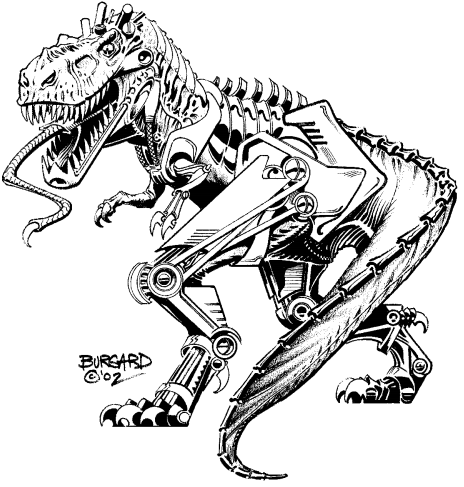
Dinosaurs as Weapons
Ah, yes, the warfare section. This piece on how dinosaurs are utilized in the Union-Confederate War is split up into various subsections, each with its own information. I'm basically going to condense them into bullet points, though, as a lot of it has either been stated before or isn't that important to a succinct review.
-
Cavalry Mounts:
Confederates use lots of dinosaur cavalry, while the Union has some lobotomized
Allosaurus
and little else as far as mounts go.
-
Armored Dinosaurs:
Dinosaurs are thick-skinned, but it never hurts to be prepared. Most rough and tough Bronco Riders put hide armor on their mounts, while big name Confederate warriors can sometimes get access to flak jackets and force fields for their saurian companions.
- Cyborg Dinosaurs: If you recall, the Confederates have been surgically giving raptors metal claws. The Union, however, has much larger goals for what they see as the perfect biological weapons. Goals like giving ceratopsians laser lances for horns, implanted poison glands, and subdermal armor. Apparently these super secret experiments are too much on some minds, though, and some Union scientists go crazy - there's a little anecdotal story about a Union machinist named Louie Wilhelm that covers that topic:
Cretasus Adventure Guide posted:
After slipping out of a top secret research base, Canada Louie Wilhelm became legendary for his attempts to transplant human brains into ceratosaur bodies. When Union troops finally tracked him down, they found his base completely abandoned but surprisingly well-stocked. A few cryptic notes claimed success in the experiments. They also found the headless corpses of several wealthy elderly men. Union spies still keep a watchful eye for Canada Louie, who knows far too many secrets, although they scoff at his extravagant claims – in public. In private, they’re worried.
-
Flying and Aquatic Dinosaurs:
In spite of the title, this is about pterosaurs and plesiosaurs in warfare. The Union is known to use plesiosaurs as suicide bombers against enemy ships, while both Confederate and Union "air forces" are pretty much reliant on pterosaurs. There are some white-marked
Pteranodons
that act as civilian package couriers as well, which spies often pose as.
- Union vs. Confederate Views on Dinosaurs: I'm going to quote pieces of this subsection and just let them speak for themselves. Nothing I can say can do as much to them as their own words.
Cretasus Adventure Guide posted:
The Union has little respect for dinosaur life. Merely clever animals, they’re tools to be used in order to crush resistance and destroy the enemy. Raptors, allosaurs, and other intelligent dinosaurs are to be treated just like other less-developed aliens: as means to an end, as drones and cannon fodder. Union courts have ruled that dinosaurs are chattel with no rights: they can’t own property, can’t testify in court, can’t even travel in Union-controlled territories without government permission.
[...]
The Confederates view dinosaurs as allies, not tools. Confederates sign and respect treaties with raptor tribes. They value and treasure their relationships with lesser dinosaurs, even as they attempt to understand the sentience of the brighter species. The Confederacy has a deep respect for the capabilities and powers of the dinosaurs; even when they find themselves fighting a particular group of dinos, they’re always careful to treat their opponents with caution. Of course, the greed intrinsic in individual humans is still a limiting factor on the attitude of any particular Confederate citizen.
The chapter ends with some rehashing of basic d20 combat rules as they apply to dinosaurs, but somehow I don't think I need to skim over a remedial lesson on grapple checks for this overview.
-----------------------------------------------------------
Next time: We breeze through the somewhat thin chapter on new Player Character options.
Wherein Players are Thrown a Bone
Original SA post
Chapter 3: Wherein Players are Thrown a Bone
If you hadn’t guessed by now, a chapter dedicated to new player options in a book very much billed as a Game Master’s guide is not exactly populous by any stretch of the imagination. Still, it’s here, so I can’t very well ignore it.
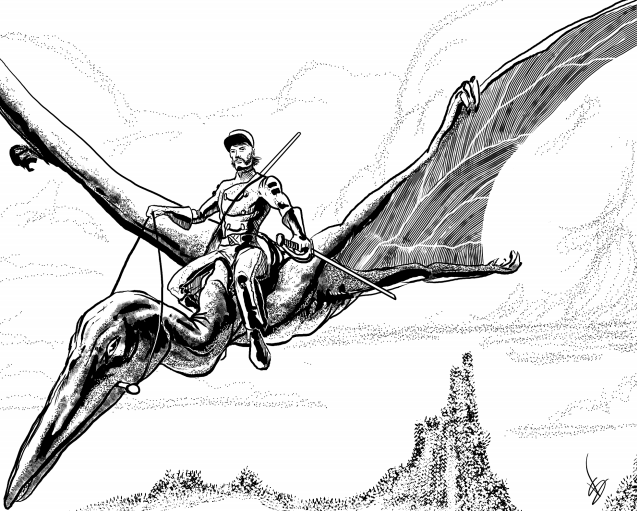
Dino Warrior
A prestige class for Confederates or Confederacy-loyal Offworlders, the Dino Warrior is basically an extension of the Bronco Rider base class that focuses it down into being somewhat more useful. Full Base Attack Bonus progression allows a Dino Warrior to deal out more damage than if the character had staid pure Bronco Rider, d10 hit die lets the Dino Warrior stack up HP at a decent rate, high Fortitude save progression is nothing to scoff at, and abilities focused on having a tight bond with a specific dinosaur mount allows for tricks like adding his dinosaur’s Challenge Rating to Intimidate checks and eventually automatically succeeding in any Ride check as long as he is unimpaired.
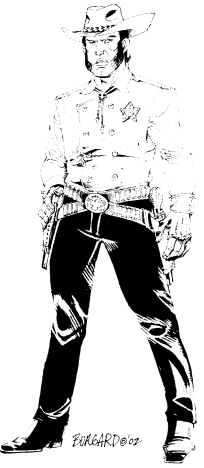
Federal Marshal
Available to Union members, the Federal Marshal prestige class reflects the best lawmen out on the frontiers of the cosmos. I’d arguably say that this is up there with the Machinist as examples of Broncosaurus Rex actually being forgiving to Union players, as it’s one hell of a powerhouse. Full Base Attack Bonus progression, d10 hit dice, high Fortitude and Will save progression, and lots of Diplomacy-related abilities such as posse-forming and law-giving basically let the Frontier Marshal be both a meaty combatant and fill the party’s “diplomancer” role. The fact that the class allows requisitioning of fancy Union equipment doesn’t hurt either.
Skill Evolution
This segment lays down rules on transferring points from one skill to another as your character grows and changes. Took some skill points in Hide that you thought would be useful, but have only been a burden ever since your GM decided you’d be out on the open waters of Plesiosaur Bay? Fear not, you can take about six months transitioning your Hide points into something like Swim. Hopefully your GM won’t decide that those six months will be in real time sessions.
New Feats
There aren’t a huge mountainous pile of new feats, just three. As such, I will go through them in a brief list.
-
Bargain Hunter:
A feat that lets you turn Gather Information skill checks into profit by buying gear at cheaper prices. The feat can also be used to find individuals who will pay more for gear you are selling. Not really a bad feat if you are a party member who doesn’t need a lot of crucial combat feats stacked up to the ceiling.
-
Fast Talker:
+4 to Bluff checks when in conversation. Your usual “I want more skill points now” take-it-and-go feat that you might end up regretting down the road.
- Permanent Enhancement: A feat for 5th level or higher Machinists. This lets a machinist turn custom upgrades into permanent enhancements that don’t fill up his “meter” for how many customizations he can have on the item in question. While this does allow for potential upgrade spam that turns an everyday pistol into a Mega-Doom Gun of Smiting Everything, there are steep monetary costs and experience point loss to attempt to mitigate just utterly breaking the system.
New Equipment
Speaking of new goodies for your character, the last portion of chapter 3. Right off the bat are the weapons, since what’s a roleplaying game without some new toys of mass destruction?
-
Hollow Point Ammo:
Ammunition that adds +1d6 to damage rolls, but suffers a -2 penalty to attack rolls on anything that has more than light armor/thin skin. It’s also rare, so I somehow doubt you’d be using it much in any adventure.
-
Laser Sniper Rifle:
A long-range laser rifle, obviously. You’re treated as prone when firing it.
- Reactive Truncheon The favorite weapon of the federal marshals and Union riot police, the reactive truncheon is a metal baton that has a kinetic enhancement field that allows it to subdue people with minimal effort or just outright kill someone in an insane bludgeoning frenzy.
The segment on weapons is followed by a breakdown of hide armor bonuses that differ based on the type of creature the hide happens to come from. If you don't care for minutiae and feel that hide armor is hide armor no matter what, you have nothing to look forward to. There are absolutely no new armors here, just a case of dividing up an old armor category.
Finally, there are five pieces of general equipment. There's an incubator, a device for hearing subsonic dino-talk, another for speaking subsonic dino-talk, a tiny camcorder-crystal, and Tyrannosaurus rex musk gland secretions.
Cretasus Adventure Guide posted:
Dinosaurs will instinctively avoid a character covered with tyro musk. In order to attack a character who has not already attacked, a dinosaur must make a Will save, with a DC of 25 minus 1 per hour passed since the musk was applied.
----------------------------------------------------
Next times: enough tables to fill an Ikea.
Time to Throw the Tables
Original SA post
Chapter 4: Time to Throw the Tables
Chapter 4, entitled "Gamemaster Reference", could also be fairly dubbed as "Tables: the Chapter". Still, it is part of the book, so I can't be fair to it if I simply skip over an entire chapter.
Generating Settlements
If you hadn't noticed before, a lot of Cretasus is either unsettled or made up of nameless generic villages, ranches, and towns outside of the big name locations seen in chapter 1. This segment allows you to roll upon many tables to create a settlement if you just aren't in the mood of designing one on your own. There are seven tables in this section alone: one for rolling up the size of a settlement (which determines population, maximum tech level availability, NPC totals, and the highest amount of cash a character in the settlement will have), one for the economic staple of the settlement such as ranching or tradecraft, one for holds the most power in the settlement, one for the number of establishments such as saloons and banks the settlement has, one for what faction (if any) the town is loyal to, one for the class and level makeup of the settlement residents, and one for the population of non-human members of the settlement. There's not really much of note here.
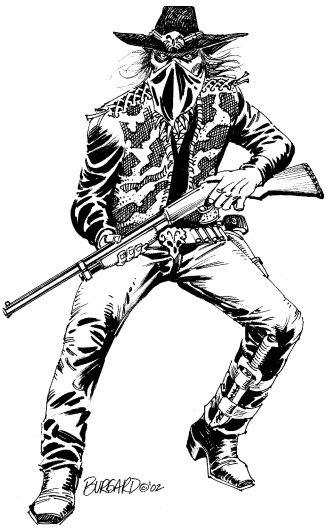
Typical NPCs
A collection of generic NPCs for your use. Statted up are a bank manager, bartender, blacksmith, claim jumper, dino rustler, doctor, farmer, fisherman, hunter, land speculator, logger, machinist, mayor, miner, outlaw, peddler, pioneer, ranch hand, sheriff, deputy, shopkeeper, Confederate soldier, Union soldier, and wealthy merchant. While this may seem like a good variety, it highlights a big problem with a lot of Broncosaurus Rex's material. Nearly all of the NPCs are first level, with the exceptions being the mayor, sheriff, and wealthy merchant that are all second level. Indeed, if you recall, there were no high level dinosaurs in the core rulebook, and only some mid-levels. Broncosaurus Rex has this problem where it seems to not recall that it is a game where characters can get up to level 20 - pretty much everything is geared toward levels 1 through 10.
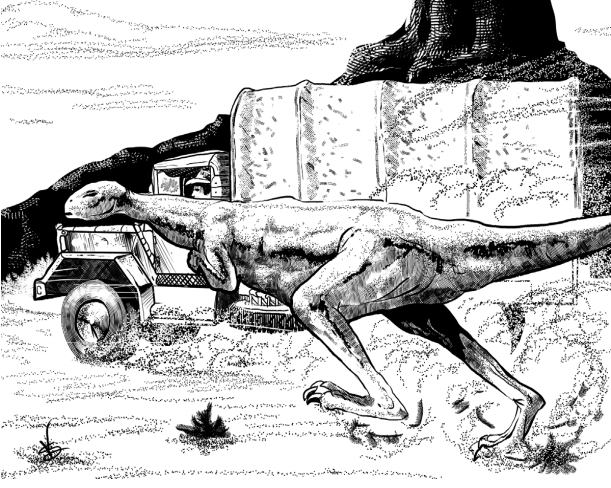
Getting Around Cretasus
While there are some general rules and tables on the cost and efficiency of dinosaur mounts, horses, and stage coaches, what I'll mostly be focusing on as far as this segment goes are the vehicle rules. Yes, dear readers, there are indeed vehicle rules to finally allow you to get some use out of the Drive and Pilot skills from the Broncosaurus Rex Core Rulebook, and even more was planned for the vehicle sector:
Cretasus Adventure Guide posted:
We won’t even attempt to go into detail on air or space vehicles – they would fill a whole book. The purpose of the rules herein is to give you simple guidelines for dealing with the typical overland adventure. Future supplements will delve into greater detail.
Treasure Tables
They're treasure tables. I don't feel I need to explain treasure tables.
Encounter Tables
Same as above, but it does illustrate the leveling problem I mentioned previously. The encounter tables are very bottom-heavy - fractional and Challenge Rating 1 are exceedingly hefty, while the highest tier only has the CR 11 brachiosaurus from the Broncosaurus Rex Core Rulebook and the CR 10 colossal monstrous spider and CR 11 colossal monstrous scorpion from the D&D Monster Manual.
--------------------------------------------
Next time: We cover the first half of the bestiary chapter, from Albertosaurus to Leptoceratops .
Of Hornheads and Helmet Fish
Original SA post
Chapter 5, Part 1: Of Hornheads and Helmet Fish
Coloration
If you thought the tables upon tables were gone with the end of chapter 4...well, you were wrong. Chapter 5 starts out with a segment on standard creature coloration as well as unusual color patterns, such as the "tiger-striped tyrannosaurs of the northwestern plains". There are table roles for percentages of atypically-colored creatures (for the curious, Tyrannosaurus and Velociraptor have the highest percentage of potential unusually-colored individuals, while Compsognathus and all pterosaurs have the lowest) in three categories: habitat-based color schemes, unusual colors, and unusual patterns. The two "unusuals" are in the same category, so you can actually mix and match them.
For an example of the system in the most stupid manner possible, let's do a completely rigged "roll of the dice". For a Triceratops , a d100 roll of 1 to 10 will get us a roll for habitat-colored variation, 11 to 25 will get us an unusual color scheme and/or pattern, and 26 to 100 will just be a normal-colored trike. Let's say we have rolled a 15, solidly in "unusual colors and patterns". We'll do both.
On the unusual patterns table, we've rolled a 53 - 51 to 60 is "alternating bands". Well, that means we need color bands, don't we? Let's say the roll is an 80. 76 to 100 is "roll twice an combine the colors), so two rolls give us 35 and 67. 31 to 40 is "white and red", while 66 to 70 is "blue and white". This means that our end result is a trike with alternating bands of red, white, and blue scales. Americasaurus is go!

You could also do actually sane things with the tables, of course, like an albino Pachycephalosaurus or a swamp edge-stalking T. rex with a dull gray hide coated in dull blue splotches.
Subspecies and Mutations
After informing us that mutant dinosaurs should be very rare (1 in 1000, if that), this segment gives yet another table of rare mutations you can give dinosaurs. These range from opposable claws or increased intelligence to chameleonic skin or gills, with plenty of things in between. And what is the very first one on the table?
Cretasus Adventure Guide posted:
d%: 01-02
Mutation: Fur or Feathers
Effect: Extremely rare specimen on cusp of major physiological evolution - of great value to biologists.

Anyway, let's get on to the actual bestiary entries. Just like last time, I'll be giving the challenge rating of each creature in parentheses next to their name. This time, however, I will also be giving the local yokels' nicknames for each critter in parentheses rather than attempting to shoehorn them into the text.
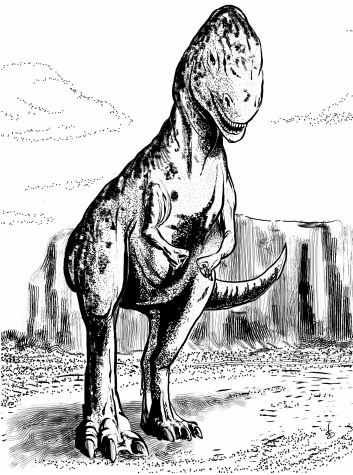
Albertosaurus ("Packmouth"; CR 7)
Albertosaurus fills the True Neutral role of the similarly statted Chaotic Evil Ceratosaurus and Chaotic Good [iAllosaurus[/i]: a predatory size Huge theropod on the lower-middle Challenge Rating curve. They hunt in packs and are infamous amongst the ranchers of Cretasus for their disastrously effective group hunting tactics. Oddly enough, in spite of being neutral rather than typically evil and presumably less likely to want to cause horrible destruction, they are less popular with Confederate bronco riders than rexes.
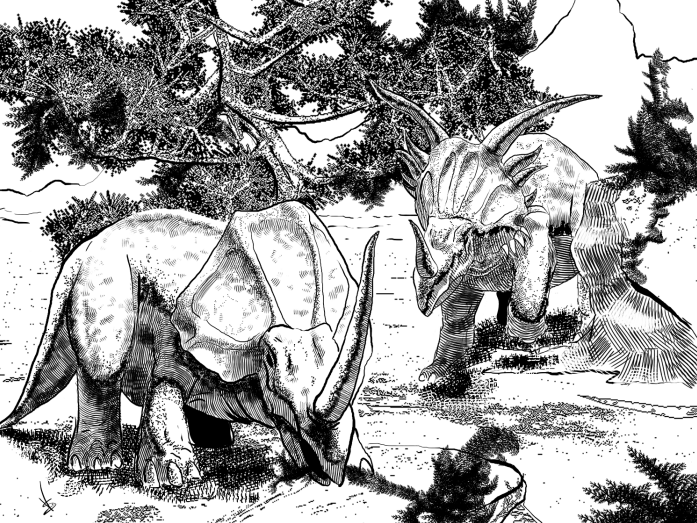
Ceratopsians, Styracosaurus ("Thrasher"; CR 4) and Monoclonius ("Longhorn"; CR 4)
These two "broncos" are basically smaller and weaker equivalents of Triceratops as far as game roles go. They're big, ornery herd herbivores that humans round up in ranches to use as food in spite of their sapience, and are popular as mounts. There aren't that many differences between the two: Styracosaurus lives in slightly smaller herds and have three gore attacks, while Monoclonius has larger herds, a few barely higher ability scores, a stronger single gore attack, and the ability to inflict double damage on a charging attack.
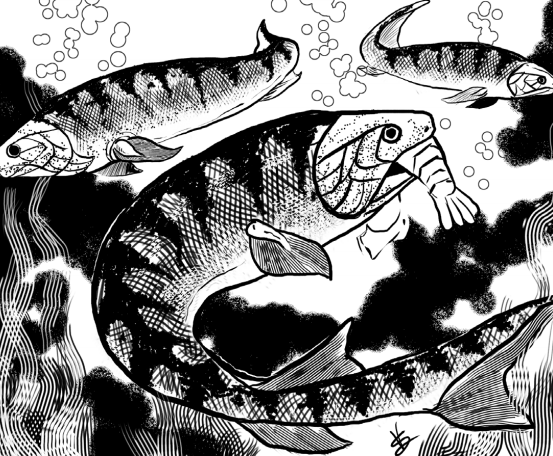
Cheirolepis ("Needle Biter"; CR 1/4)
Do you need baby's first aquatic encounter? No? Well, these little nippers are in the book anyway.
Okay, to be a bit more fair, Cheirolepis are meant to be played as group hunters, with the number of biting jaws being more dangerous than a single fish of the school. Still, they are yet another low-level creature in a game that has a huge void for half of the potential character levels. They are also not a proper swarm as defined by D&D, meaning that you will be bogged down with having to track each of the fish you are tossing at your players rather than a single cohesive unit.
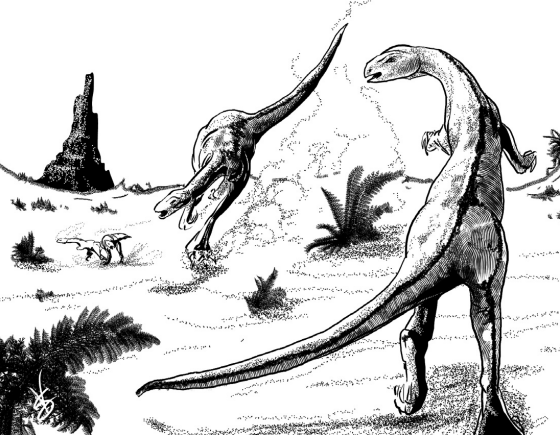
Dryosaurus ("Dinosaur Gazelle" or "Grass-Runner"; CR 1)
One of the few dinosaurs known from the enigmatic and barely human-settled Northwestern Plains region of the central valley, Dryosaurus are stated to be playful and extremely alert herbivores that travel in huge herds. Humans back in the more habitated parts of Cretasus have become enamored with these swift saurians and will pay good money to have them as pets or scouting mounts.
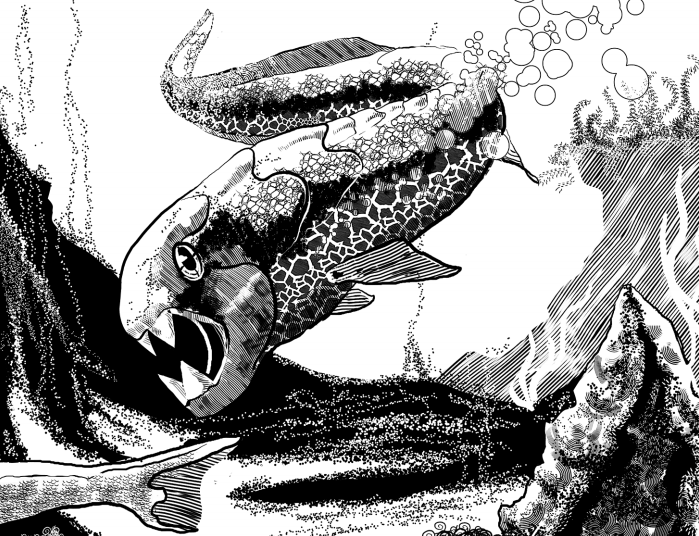
Dunkleosteus ("Helmet Fish"; CR 2)
One of the most famous Devonian placoderms, the power and size of Dunkleosteus are downplayed in this title to once again enforce this strange habit of shoehorning every creature into the first half of a character's career. They are treated as only marginally stronger than a weak shark, with their main asset being the ability to grapple and then grind its mouth plates into a foe's flesh. I know, I know, I've repeated this point before. I'll try to avoid going over it for every monster, but the short-sighted Challenge Rating curve is sort of the elephant in the room at this point.
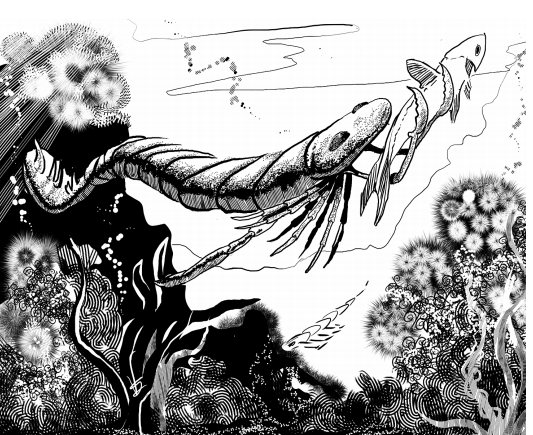
Eurypterid ("Sea Scorpion"; CR 1)
These stats reflect one of the larger eurypterid species that once roamed Earth's oceans, most likely the 7 foot long whopper Pterygotus . They sort of swim around in the shallows and snap at you with their pincers, and not much information is given on them.
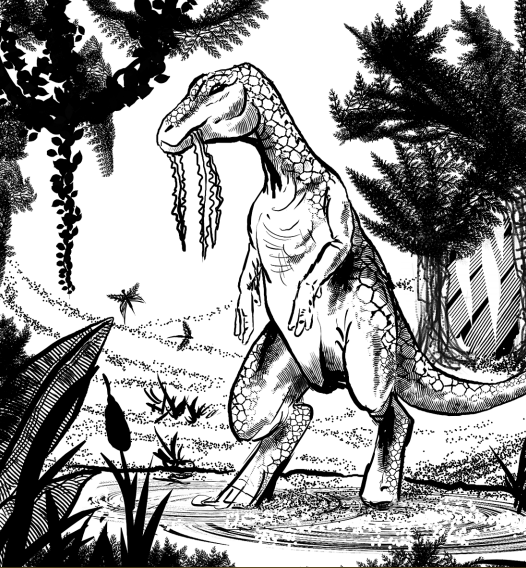
Hadrosaurs ("Duckbilled Dinosaurs"), Bactrosaurus (CR 2) and Edmontosaurus (CR 5)
Parasaurolophus in the core rulebook was meant to be the size Huge representative of the hadrosaurs - Bactrosaurus and Edmontosaurus sandwich it as the general representative of size Large and Gargantuan respectively. Not much here that is new over the core hadrosaur fluff, save for informing us that hadrosaurs of various species gather their herds together in one massive mega-herd known as a "hadrosaur city".
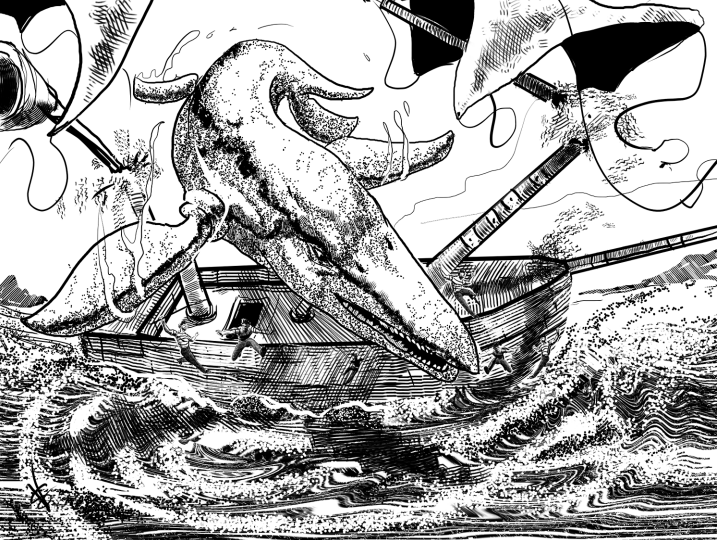
Kronosaurus ("Oceanius Rex"; CR 8)
These massive "sea rexes" are one of the greatest mysteries of the main valley's inland seas. They are never seen together, never seen in the same place twice, and barely ever seen at all. No big game hunters want a krono head on their wall, but no one has managed to get one. No attempts to capture one alive have ever succeeded, and no mating specimens have ever been found to gather young from. What is known is that they are Neutral Evil, extremely strong, and have a fondness for breaking boats to bits before slowly picking off drowning sailors. Oh, and then there's this:
Cretasus Adventure Guide posted:
The well-known dino handler “Jaws” Giovanni, famed for having trained four T-rexes with his own hands, met his death while trying to capture and train a kronosaurus. They are hard to locate and nearly impossible to capture.
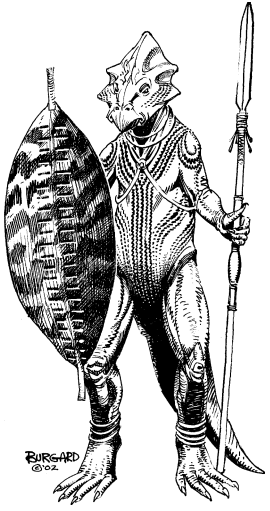
Leptoceratops ("Zulep"; CR 2)
As mentioned in the gazette segment on the Great Library earlier on in the book, these ravaging barbarians are a relentless culture of warriors. They also happen to be a cocktail of "fierce warrior" stereotypes about the Zulu (a big hint being the nickname "Zulep") and First Nations peoples. Leptoceratops have natural barbarian rage, are resistant to fire damage, engage in ritual scarification, drink the blood of their enemies in spite of being herbivores, are stated to be weak to regimented forces that their chaotic combat style isn't meant to face, and have a coming of age ritual where they must take the scalps of a number of large creatures equal to how many years they have lived. They caused the extinction of at least two other ceratopsian species - the "weaker" Bagaceratops and Psittacosaurus - and have made plenty of attempts to wipe the scholarly Protoceratops out as well. Basically, they are the desert-dwelling, plant-chewing equivalents of the raptors right down to sharing the ability to take class levels to advance, and are meant to be used in pretty much the same way.
----------------------------------------------------
Next time: The rest of the bestiary from Plesiosaurus to Vulcanodon , as well as the Ironclad template.
The Rest of the Bestiary
Original SA postRedeye Flight posted:
If it hasn't been officially released yet, I'd say wait for that. I'd definitely be in support, though, because I've never heard of anything even TRYING medieval Africa and it sounds absolutely freakin' boss.
And speaking of lost worlds, I should probably get finished with the Cretasus Adventure Guide, shouldn't I?

Chapter 5, Part 2: The Rest of the Bestiary
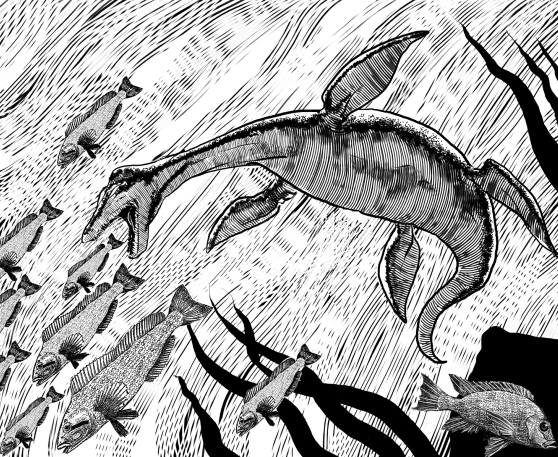
Plesiosaurus ("Sea Wolf"; CR 2)
Plesiosaurus are rarely depicted in media compared to the much larger and more visually impressive elasmosaurs. With a game so front-loaded as Broncosaurus Rex, though, it's not surprising that these relatively small plesiosaurs are present. Fishermen treat them as pests, as they are prone to ripping through fishing nets and stealing catches. Plesiosaurus are not large enough to desire humans as a fleshy treat, but they can be quite violent of provoked, which many fishermen often accomplish by trying to club them in a seal-like fashion.
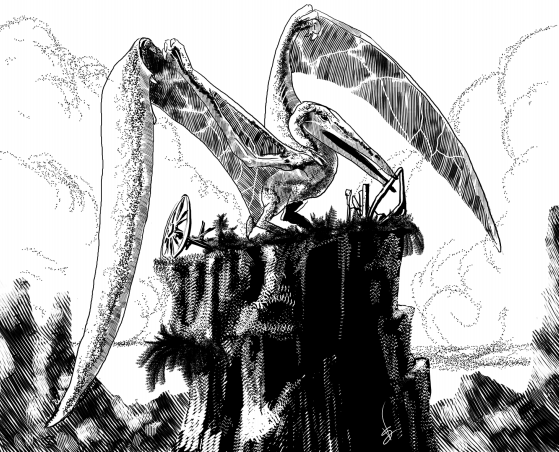
Quetzalcoatlus ("Graywing"; CR 5)
Another case of some of that James Gurney influence strongly creeping in. Like Dinotopia's Quetzalcoatlus , those of Broncosaurus Rex are written as cliff-dwelling scavengers that are popular as mounts for high-flying pterosaur riders. This is one of the entries that has definitely not aged well, as perception of Quetzalcoatlus and its relatives has become less that of pterosaurian vultures and more as badass giraffe-storks of doom .
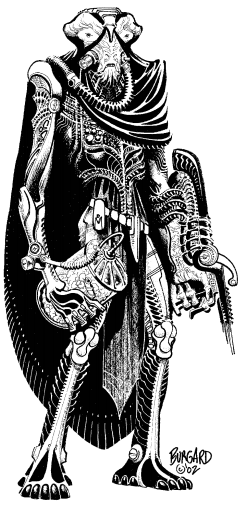
Scray (CR 2)
Meet the Scray. As the first extraterrestrials humans of the Broncosaurus Rex universe encountered, they get the honor of being the only ones that actually have in-game statistics. Scray are technophilic introverts, not giving one ounce of care for the petty squabbles of the Union and the Confederacy but very interested in what new toys they can get from human traders. Confederate gentry and Free Fleet merchants tend to dislike the Scray due to the fact that they have no desire for the green paper we use as currency, but can be swayed with something as simple as an Earth chemical they haven't encountered before. The Union has apparently found something that these enigmatic aliens want, at least, as Scray are known to work on Ironclad designs in exchange for something that only the most elite Union machinists know about. All Scray have biological armor that is grown into them and supplies them with their home atmosphere, medical nanites, a translation device, and any number of high-tech gizmos they happen to fancy. This means that if you happen to force a normally placid Scray into combat, they are quite capable of using their defenses, fast healing, and powerful weaponry to curbstomp you.
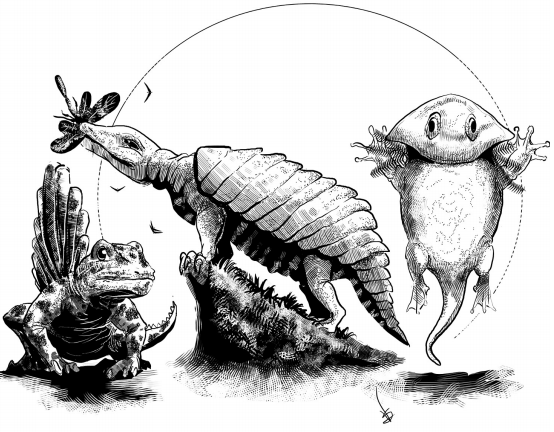
Small Game, Tiny (CR 1/6) and Small (CR 1/3)
The Cretasus equivalent of rabbits, game birds, and other inconsequential underbrush entities that frontier people hunt and trap for minor everyday sustenance or for sale as pets. Other than a few minor alterations and tiny bits of text, the specific types of small game mentioned below the two major stat blocks are inconsequential. Interestingly enough, all but one of the listed small game are from Earth's Permian period - the three illustrated for the entry are Platyhystrix (nicknamed "spinyback"), Peltobatrachus ("fatball"), and Gerrothorax ("flathead", the only Triassic small game animal listed).
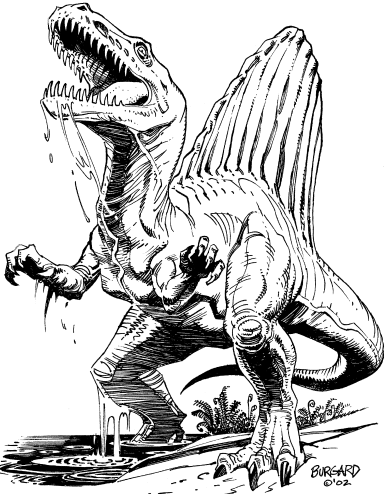
Spinosaurus ("Swamp Lurker"; CR 7)
The native apex predator of the Bayou, Spinosaurus is an ambush predator that is stated to dwell in prides of 3 to 9 members. While objectively weaker than Tyrannosaurus or Allosaurus , the spinos are brutal and devious combatants that will utilize their swampy environment to put all of the cards in their hand. In spite of their power and mastery of the swamp, however, humans find little use for them. They smell just as foul as their tempers, meaning that hides and mounts are both highly unlikely. The local bags of crazy that are the human trophy hunters will seek spinos for their sails, though.
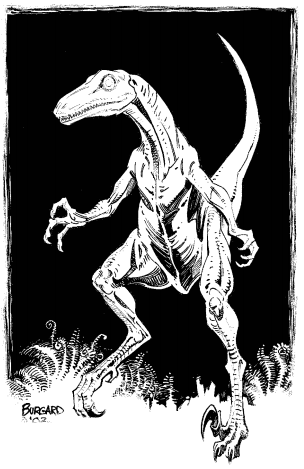
Stenonychosaurus ("Moon Lizard" or "Ghost Dino"; CR 1)
Pale-skinned, large-eyed, and generally creepy, these swift nocturnal theropods are found all over but pretty much never seen unless they desire to be seen. Stenonychosaurus have a disturbing tendency to appear in groups and plop down writings with obscure communications of warnings - namely, in spite of having an Intelligence score of 17 (7 more than a standard human
 ), they write English in the same way that you might after drinking several bottles of alcohol and then being struck with a frying pan. This leads to them being seen as strange prophetic figures, with many dinosaurs considering them to be ancient lorekeepers and the
Protoceratops
in particular claiming that the stenos have a direct line to saurian humanoids that dwell somewhere on Cretasus. Is this merely a ceratopsian myth? No, but we'll get to the scalies in the next and final Broncosaurus Rex books.
), they write English in the same way that you might after drinking several bottles of alcohol and then being struck with a frying pan. This leads to them being seen as strange prophetic figures, with many dinosaurs considering them to be ancient lorekeepers and the
Protoceratops
in particular claiming that the stenos have a direct line to saurian humanoids that dwell somewhere on Cretasus. Is this merely a ceratopsian myth? No, but we'll get to the scalies in the next and final Broncosaurus Rex books.
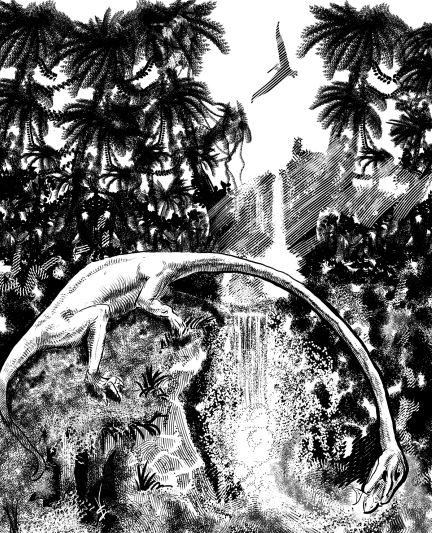
Tanystropheus ("Long Biter"; CR 1/2)
You've probably seen an image of these freakish Triassic reptiles somewhere before. While the actual creatures were coastal fish-eaters, those of Broncosaurus Rex dwell in jungle underbrush and are poisonous. They are also obscenely low Challenge Rating like damn near everything else, so ultimately these little embellishments are inconsequential as Tanystropheus are not any more difficult to fight than the umpteen-hundred other first level adventurer fodder.
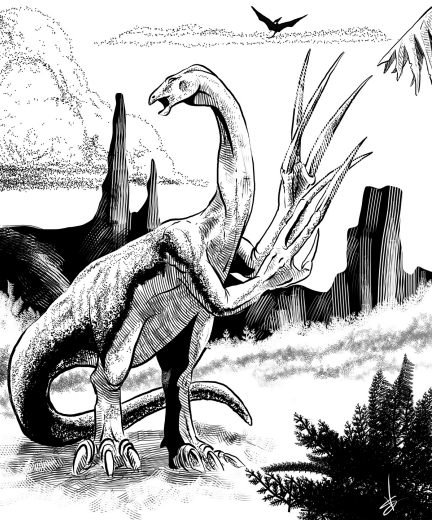
Therizinosaurus ("Reaper"; CR 5)
Another strange creature you've probably seen an image of at least once, Therizinosaurus is known for being a herbivorous theropod with a pot belly and insanely long claws. Broncosaurus Rex oddly portrays them as insectivores that speak the language of sauropods rather than theropods. They are relatively popular amongst farmers for use as living field plows, while Wild Ones will use "reaper claws" as impromptu longswords.
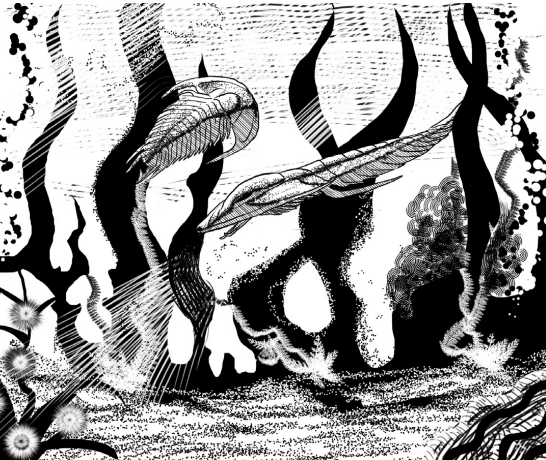
Trilobites ("Scurry" or "Sea Bug"), Common (CR 1/8) and Giant (CR 1)
In a two-for-the-price-of-one entry, you get both real life miniscule trilobites that cannot really do anything at all in combat and fictional human-sized trilobites that are incapable of really menacing anything beyond a first level human character. Indeed, the example of trilobites being dangerous to humans describes someone falling asleep on a beach and finding trilobites scraping off harmlessly impotent bits of his flesh. Ooh, so scary .
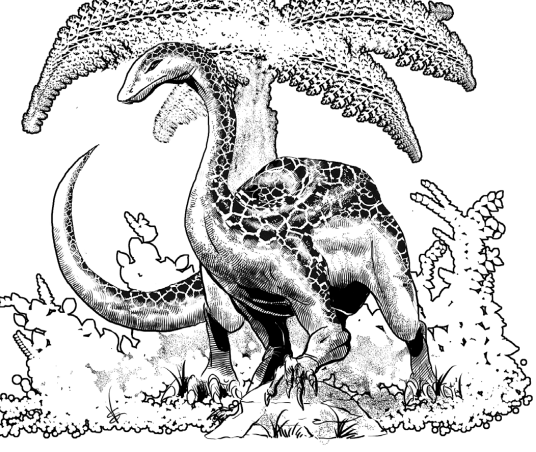
Vulcanodon ("Flamer" or "Stomper"; CR 6)
At only around 20 feet in length, the size Huge sauropods are relatively small as far as long-necked dinosaurs go. Loggers and others that need beasts of burden will often choose Vulcanodon over Brachiosaurus , as a large group of the former are proportionally stronger and easier to raise rather than a single specimen of the latter. They also happen to be somewhat afraid of open spaces and aren't really useful as mounts outside of forests.
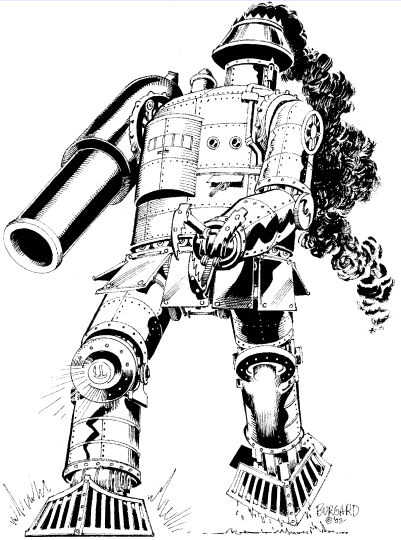
Ironclad
That's right, we've finally reached the actual premiere of a piece of equipment whose piloting skill was introduced one book ago! Three forms of ironclad have been created by the Union so far, each with their own specific features.
-
Monitor:
The smallest of the ironclads, the 12 foot tall Monitor-class is basically the scouting model. It is outfitted with jump jets and a generall light frame, a Monitor in combat relies on its clawed arms and a grenade launcher containing 10 of both frag and smoke grenades.
-
Ulysses:
16 feet of metal monstrosity, the Ulysses-class ironclad wields a giant hydraulic claw arm, heavy machine gun, and the grenade launcher of its smaller cousin.
-
Sherman:
The Sherman-class ironclad is an armless giant, standing 20 feet in height and wielding a grenade launcher, heavy machine gun, and
howitzer"howzer". It also has a vibrofield rather than the absorption field the smaller ironclads are outfitted with, providing it greater force field-related protection.
Ironclads are basically treated as a template of sorts. It effectively creates a Construct-type "creature" that has its own hit points, Armor Class, size, speed, and attacks, while at the same time relying on augmented versions of the ability scores, skills, and feats of the pilot.
-----------------------------------
Next time: I'm not sure, actually. The last book in the Broncosaurus Rex series is basically a glorified bestiary. Should I storm through it in a few posts and then do a retrospective on the series so far, or should I just do the retrospective now with the materials of the core rulebook and Cretasus Adventure Guide?
An Introduction to the Madhouse
Original SA post
Chapter 1: An Introduction to the Madhouse
“Dinosaurs That Never Were” posted:
Where the first two Broncosaurus Rex books focused on creatures with low CR (the better to start low-level campaigns with), this book expands into the higher CRs.
This sourcebook, in addition to being mostly bestiary, introduces Storm Valley. Storm Valley has a various obvious reason for its name – while the Eurasia-sized valley itself has a normal atmosphere, the mountains that surround it hold up a strange eternally roiling thundercloud that obscures the valley from any attempting to view it from the outside. The valley has a ring structure to it, with the valley as a whole containing an inland sea the size of the Atlantic, which itself contains an Australia-like island continent. The outer ring is a mixture of jungle to the south and savannah and desert to the north, the inland sea has enough localized storm action that is it known as the Tempest Sea, and the island continent of Carsonia is a mess of mountains and jungles that is obscured in mist. The northeastern savannahs also have massive stone cities, from which stories flow of giant theropods with cruel gladiatorial bloodsports and a genocidal streak a mile wide towards anything that dares to challenge their dominion. These stories are true, of course, as the valley as a whole is home to numerous dinosaurs and other prehistoric creatures that have evolved into forms they never had on Earth.
Pretty much the entirety of the human presence in Storm Valley is centered around the far south, where the unreliable but nonetheless viable passage known as Connor’s Pass allows for ground vehicles to tread into the valley. The sole Union presence is Fort Phil Kearney, a defense-laden structure under constant siege by theropods, sauropods, and pterosaurs that have all formed truces with each other to attempt to kill off the Union humans that have entered the valley. By contrast, the Confederacy has set up mining efforts in the iron- and copper-rich mountains to the southwest and are generally ignored by the saurians of Storm Valley. There have also been a few Free Fleet efforts to scope out the valley, but they have failed for the same reason that mass exodus into the valley has failed – you can’t fly spaceships through a huge-ass unending uber-storm. This is why there are plenty of crashes around and scavenging has become a popular way of living for the few groups of humans in Storm Valley.
---------------------------------
Next time: We start on the bestiary section. There are 50 creatures in total, so I’m not quite sure of my post sorting method as of yet.
The Designers Were Horn-y
Original SA post
Before I get on to the first part of the Dinosaurs That Never Were chapter 2 bestiary madhouse, I have an announcement to make.
There's a
plot twist
afoot! Tomorrow is the last day that Margaret Weis Productions has the Smallville and Supernatural RPG licenses from The CW. In light of this event, if there is enough desire, I will be looking at the Supernatural RPG books before Mutants and Masterminds: Golden Age to see whether or not they deserve an honorable funeral or a classic Winchester brothers corpse burning.
Anyway, let's get back to the current topic.

Dinosaurs That Never Were Chapter 2, Part 1: The Designers Were Horn-y
A note beforehand: I will be referring to the creatures in this entry by their nickname, as their scientific names bear no weight as none of them actually exist and many of the scientific names in question actually make little sense when you look at what the creature in question actually looks like. The Challenge Rating will be after the nickname in the header as usual, however.
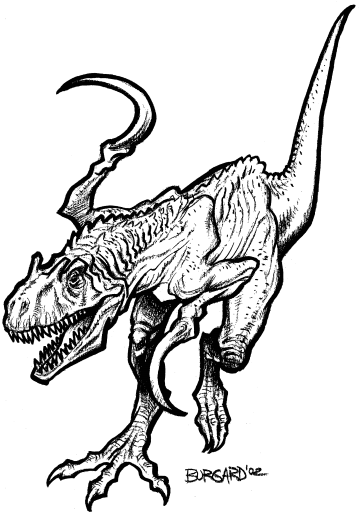
Allosaurus temnonychus ("Claw Cutter"; CR 8)
Basically a standard real-world
Allosaurus
as seen in the core rulebook, but with sickles grafted onto its arms for no real reason. They are far more aggressive than real Main Valley allos - indeed, they actively relish in fighting things and have a visceral hatred of having to scavenge. In spite of this super-aggressive attitude, claw cutters work together in large packs, hunting down large prey species with a tactic of biting wounds before ripping the wounds wider and wider with their hook-hands. These brutes are the main soldiers in the war against Fort Phil Kearny, meaning that Union soldiers are scared to death of them and their illogically massive group assaults.
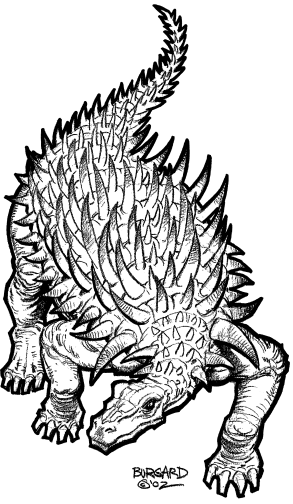
Ankylosaurus peltospinos ("Spinydillo"; CR 8)
This offshoot of
Ankylosaurus
is 40 feet in length and more aggressive than its real world ancestor (noticing a trend?). Anything in a spinydillo herd's territory - herbivore, carnivore, human, doesn't matter - is driven away with violent assaults, especially during the breeding season. In spite of being as prickly as a pineapple, spinydillos still use the classic ankylosaurian tail club as their weapon of choice. Nobody told the artist that, though, apparently.
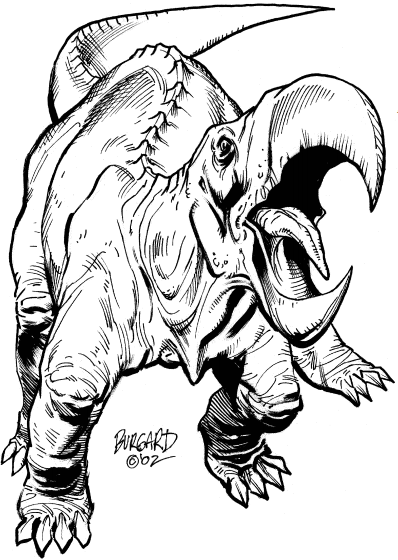
Anoplotops ferox ("Parrotbeak"; CR 7)
An oddity for this book, the
Triceratops
-sized parrotbeaks have features taken away from them rather than having frivolous adornments shoved everywhere. Without horns or even a frill, these ceratopsians compensate by having a huge beak that is capable of breaking through nearly any material. And break through materials they will: in addition to breaking apart trees to eat, the bones of carnivores and the ironclads of Union soldiers are just as likely to be snapped apart if they get within biting distance. Another atypical trait of these creatures over standard ceratopsians is that they don't really fight for mates, instead having the females pick the male whose musk gland smells the best. Humans happen to hunt for these musk glands to put in cologne. Because humans.
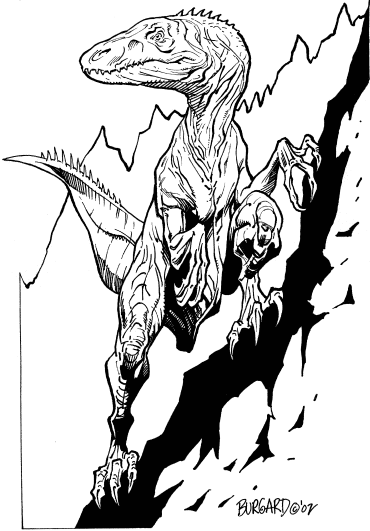
Aublysodon orogradior ("Mountain Walker", "Rock Monster", or "Stone Dropper"; CR 6)
Have you ever said to yourself "you know what I need for my campaign? A 20 ft. tyrannosaurid that hops around making avalanches!" Well, even if you haven't, the mountain walker is here for your perusal. These fleet-footed predators patrol the entirety of the mountains that surround Storm Valley and are pretty much all but stated to be used as introductory encounters for players new to the region. They also happen to be the reason that the Union can't get a greater foothold, engaging in strategic creation of avalanches and rockslides to warn non-Confederate humans that they aren't welcome.
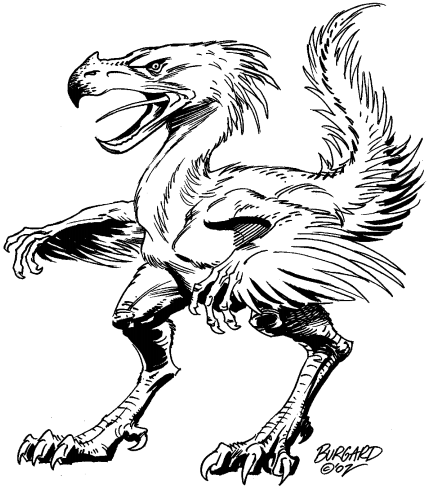
Avimimus struthioides ("Torture Bird"; CR 2)
15 feet of Lawful Evil, torture birds get their name for just the reason you'd think.
Dinosaurs That Never Were posted:
Against a totally helpless victim, the creature will draw out this prospect beyond all reasonable time, seeming to enjoy the death agonies of helpless prey. Any PC who gets caught in a bad way by one or more of these creatures when he is unable to fight back would be well-advised to save the last bullet for himself.
While they do have violent tendencies toward prey species, torture birds are pretty chill with each other. They are monogamous, settle inter-clan disputes with foot races, and take good care of their young.
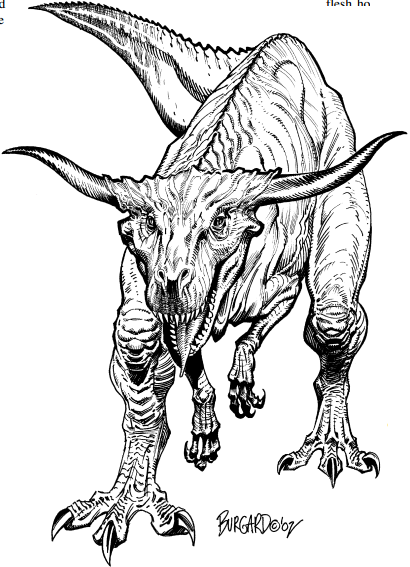
Carnocornus megalocornus ("Blackhorn"; CR 7)
Surprisingly little about the blackhorn is actually stated in the text, given that it was apparently important enough to have been one of the two dinosaurs pictured on the cover of this book. They have glossy black horns, are short-tempered, and uses its horns in a charge attack to spear prey (!). They are already coveted for their namesake attribute, as it turns out that they can be ground into Strength-boosting potions and have large status value amongst the crazy trophy hunters that dot every human-inhabited part of Cretasus.
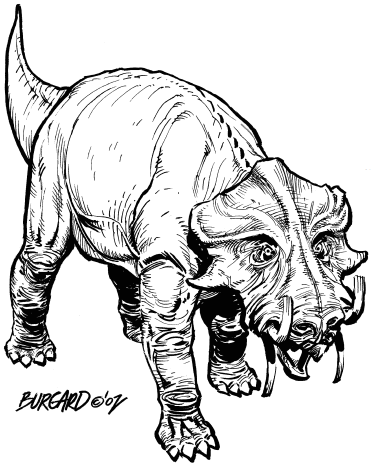
Ceratops susoides ("Pig Beak" or "Tusker"; CR 2)
Literally dinosaur pigs. They are the same size as wild boars, live in herds like wild boars, have the same diet and feeding habits as wild boars, grunt like wild boars, and are tasty to humans like wild boars.
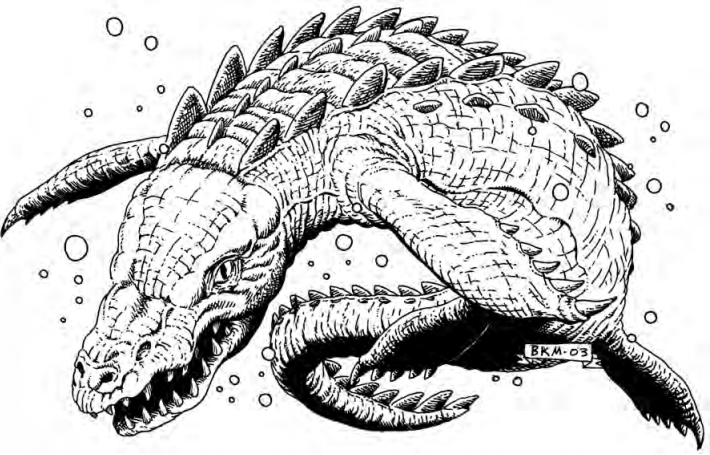
Cetiocrocodylus thalassos ("Ocean Tooth"; CR 6)
These whale-sized marine crocodiles are the main predators of the Tempest Sea. Not much is stated about them, merely that they act like crocodiles tend to act, are vulnerable on land when they heave themselves slowly to their egg-laying sand banks, and that their teeth are used to make prestigious tent pegs.
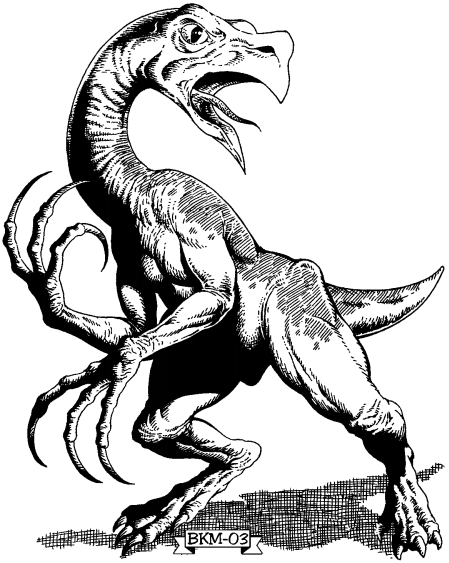
Chirostenotes temnocheirus ("Cutting Hand"; CR 2)
The cutting hand is stated to be sort of a hybrid of bear and ostrich, being an omnivore that has the solitary nature, size, and habitat of the former combined with the speed and parental skills of the latter. Their eponymous ripping claws do a number on would-be predators (2d8, which is comparable to rifle damage) and those that attempt to get near their young. When two males fight over a mate, however, they are decidedly delicate and interlock these usually deadly weapons to perform a shoving contest.
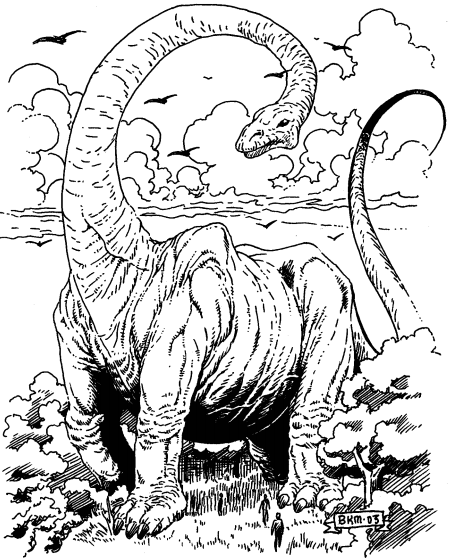
Colossosaurus cretasus ("Colossus Lizard" or "Dino God"; CR 30)
Fuck this creature. Just fuck it.
Seriously, how many times have I had to bring up the topic of Challenge Rating issues in this game? Every creature other than this one has a challenge rating from fractional to 11, then you have this bloated 90 Hit Die, Challenge Rating 30, 400 foot long thing that pushes the game into epic level territory. The only options you have in between a CR 11 Brachiosaurus and this numeric monstrosity are the few things that can take class levels or the psychic T. rexes from The Complete Guide to Tyrannosaurs.
If you want to know something about these behemoths other than my anger at them, they are stated to be untouched by predators, nearly immortal, and only lay eggs every 100 years or so. Really. If I hadn't promised myself I'd do twelve creatures for each installment of this review, I'd give up right here.
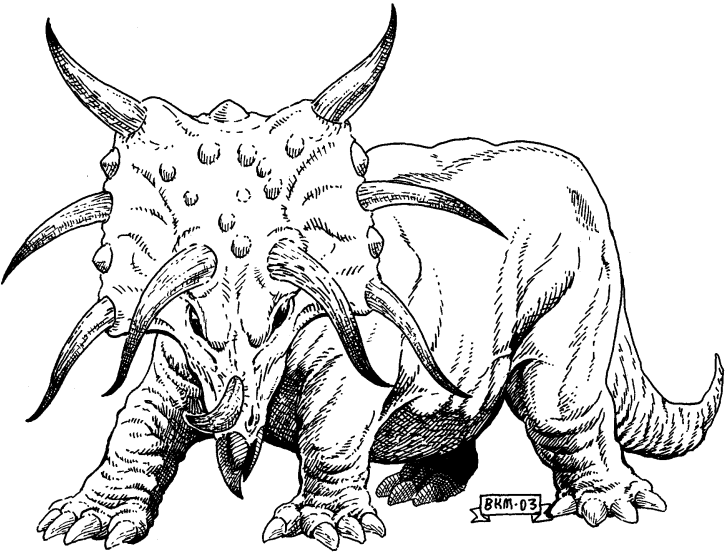
Craspedoceratops gregarium ("Horned Tank"; CR 8)
One of several creatures in this book where the designers decided to throw as many horns on as they possibly could, the horned tank is basically a Triceratops with upped damage output and a "take damage when you attack it because of its many prongs" effect.
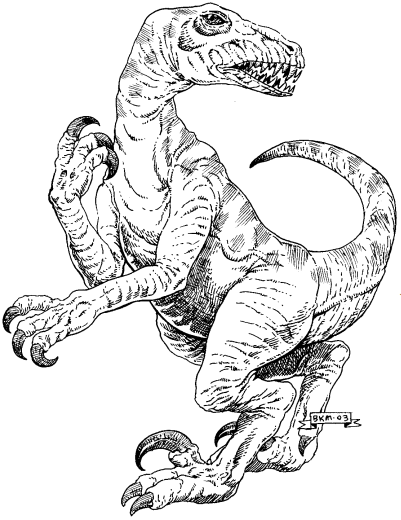
Deinocheirus gryponychus ("Shredder"; CR 8)
Look at that creature. Take a good, long look at it. It is the most
 dinosaur possible. It is supposedly a swift, deadly predator that roams the open plains of northern Storm Valley, terrorizing prey with its foot-long claws on twelve foot long arms, but I'm somehow not buying it.
dinosaur possible. It is supposedly a swift, deadly predator that roams the open plains of northern Storm Valley, terrorizing prey with its foot-long claws on twelve foot long arms, but I'm somehow not buying it.
-----------------------
Next time: The only thing that gets close to the stupidity of the colossus lizard.
Seesaw of Stupidity
Original SA post
Chapter 2, Part 2: Seesaw of Stupidity
When we last left off, we had just gotten past the gameplay headache that is the idiotic colossus lizard. Can things get even dumber?
...Yes. Yes they can.
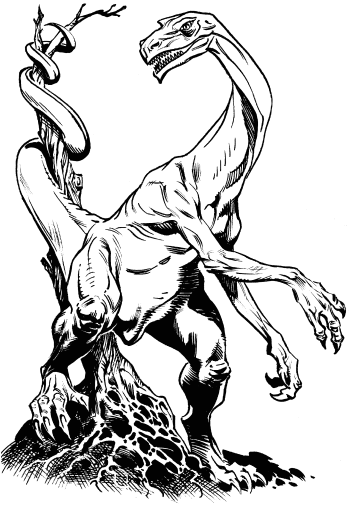
Dolichobrachios ferox ("Monkey Claw"; CR 6)
Monkey claws are 30 ft. predators that creep and crawl through mountain passes and highland forests. Unlike many of the carnivorous creatures in this book that have a "more brutal!" theme to them, these odd saurians actually prefer to avoid combat, moving to higher altitudes whenever other large predators such as the mountain walkers or claw cutters happen to be heading through. Their favored prey are small dinosaurs, small reptiles, eggs, and mountain stream-dwelling fish. If faced with a threat that won't leave them alone or an unexpected food shortage, however, monkey claws will utilize their prehensile tails to constrict around the target as they attack with their claws and teeth.
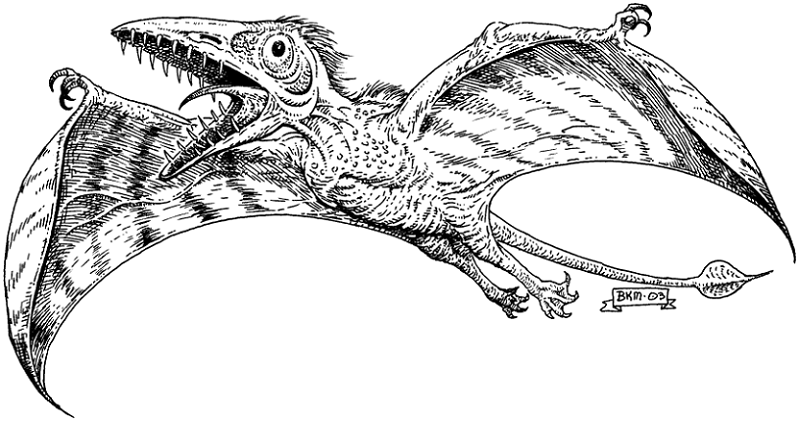
Dracoroc megalopteryx ("Elephant Bat"; CR 5)
Take a rhamphorhynchid pterosaur, inflate it to the size of Pteranodon , and give it the colors of a puffin, and you have the elephant bat. These high-flying creatures nest on the tallest mountain peaks, where even creatures such as the mountain walkers cannot feasibly reach, and are said to be able to fly through the lightning of storm valley without being at any risk. They are also known for their tendency to lift exceedingly heavy objects and then chunk them down like bombs, crushing prey and perceived foes. Indeed, they are also in on the Storm Valley conspiracy against the Union: namely, they poison the well of Fort Phil Kearny with a stream of dino corpses from the sky.
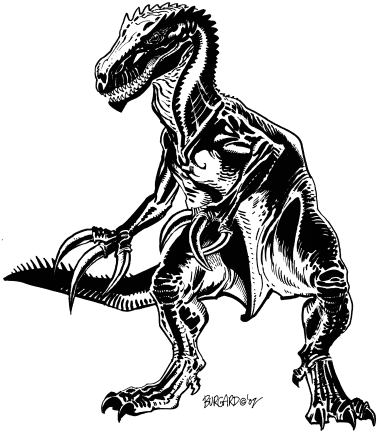
Dracotherizinos cretasus ("Stone Cutter" or "Scythe Dragon"; CR 8)
Lawful Evil dinosaurs that are basically the Roman empire, the T. rex -sized stone cutters dwell in a grand city carved by their own hands. The stone cutters believe that they are the rightful rulers of Storm Valley, though they currently only have one city and scattered clans in the northwest in comparison to the immensity of the valley as a whole, and will capture other species and keep them as slaves until these captives are sent to an immense gladiatorial arena. When not enjoying their favorite bloodsport, these giant theropods are fond of creating intricate artwork carved into their city walls or hunting down creatures in the outside world for either food or even more slaves. They are certainly not to be underestimated in combat, either, given that they can use traditional tooth-n'-claw violence as well as hurl boulders in a manner reminiscent of D&D giants.
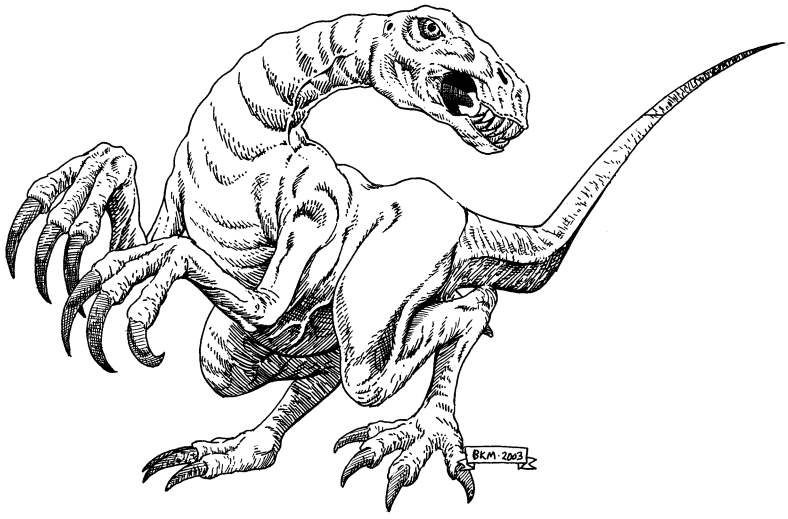
Dryptosaurus ingens ("Leaping Claw"; CR 7)
Leaping claws are more or less the surrogate ceratosaurids for Storm Valley: Chaotic Evil, ambush predators, and found along forested trails. The only really interesting thin about them is that apparently humans find their powerful hind leg muscles so delicious that they are worth $1,000.

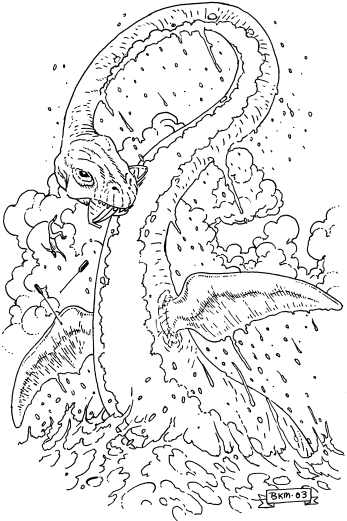
Elasmoforme ingens ("Ribbon Killer"; CR 8)
These gigantic and enigmatic sea predators are typically not seen until their serpentine necks break the surface to snatch a pterosaur or something else that is above the water line. While stated to be 300 feet in length, the ribbon killers of the Tempest Sea are somehow not worth going past CR 10, much less into epic levels like the stupid fucking colossus lizard. No, I still haven't gotten over that.
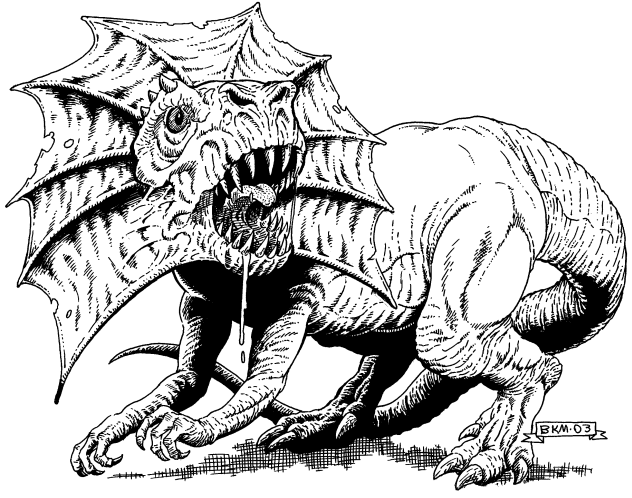
Gorgomonstrum torvovenator ("Frill Monster"; CR 7)
Another creature with not much written about it. They are about the size of your average theropod, have frills on their neck that they use to startle foes and attract mates, and they are Chaotic Good for no real reason.
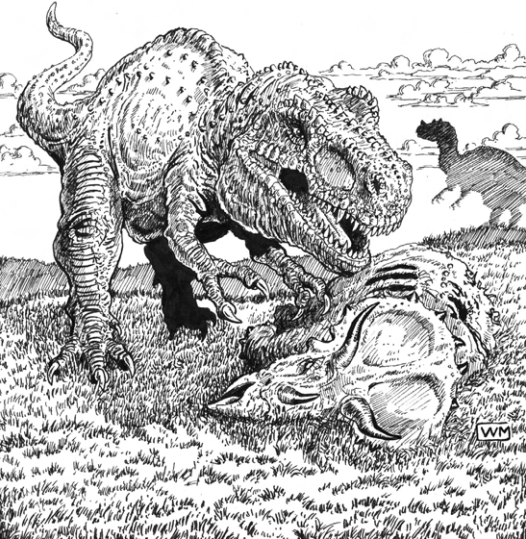
Hyaenosaurus osseophagus ("Bone-Eater"; CR 8)
More or less an extremely specialized tyrannosaurid. Just like real hyenas, the bone-eater is a brutal predator as well as an expert scavenger. Its thick arms allow it to grapple onto a target with a vice grip, immensely powerful jaws can crush bone and ankylosaur armor (or Union ironclads, as the text is quick to tell us) with ease, and a cast-iron stomach digests even the most poisonous meat without much effect. It's unsurprising that the bone-eaters' resistance to the typical theropod-slaying tactic of poisoned watering holes and their armor-piercing jaws have made the Confederacy very interested in getting their hands on some.
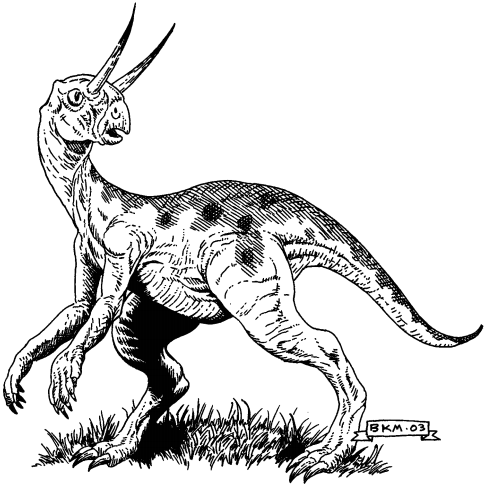
Hypsilophodon cervesaurus ("Deer Lizard"; CR 1)
Herds of these human-sized horned ornithopods roam just about everywhere in the Storm Valley and have adapted to every terrestrial habitat imaginable. Given that you can hardly travel a mile without stumbling over a herd or two of them, it isn't surprising that everything from crocodiles and swamp snakes to desert-dwelling theropods and mountain-soaring pterosaurs eat them. The fact that the males are particularly gaudy, with big red throat sacs and bright orange beaks in addition to the horns both sexes have, means that they are both tasty and trophy-worthy as far as humans see.
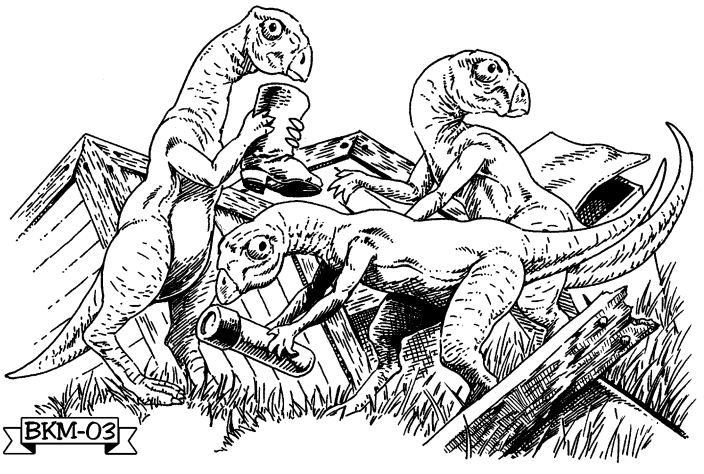
Hypsilophodon lummo ("Lizard Lemming"; CR 1/4)
Perhaps the only dinosaur whose appearance matches the sheer
 of the shredder, lizard lemmings are cat-sized creatures that herd together in the hundreds or even thousands and are specifically designed to be a big middle finger from the GM to the players:
of the shredder, lizard lemmings are cat-sized creatures that herd together in the hundreds or even thousands and are specifically designed to be a big middle finger from the GM to the players:
"Dinosaurs That Never Were posted:
Hungry lemmos will even gnaw at larger items made of wood, such as furniture, crates, shields, and gun stocks. Thus, an invasion of the party’s campsite by a horde of these creatures, which can occur at any time of the day or night, can be a major catastrophe for a group relying largely on its gear. If the GM wants to hit the party with an encounter designed to severely weaken it before the climax of the adventure, but not one that grants them huge numbers of experience points, a “dinosaur lemming" swarm is the way to go.

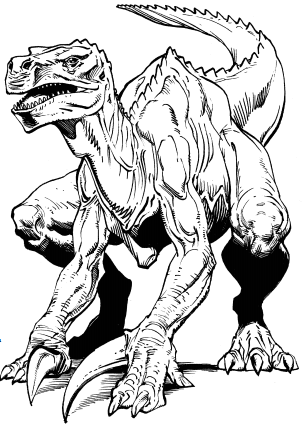
Iguanodonts - Iguanodon cultercheirus cutelluscheirus, Iguanodon gladiusnychus, Iguanodon saxnchus, and Shamshiriguanodon cretasus ("Sword Warrior" or "Blade Grazer"; CR 6)
In spite of giving four different species names, each with slightly different damage outputs, the sword warriors are basically all the same as far as the text on how they operate is concerned. Their thumb spikes have advanced beyond real world iguanodonts in both size and purpose - namely, the spikes of sword warriors are actually used for fencing contests, going so far as to actually fence with human swordsmen that happen to befriend a herd! As if this premise alone wasn't silly enough, the largest and mos well-known herd of these creatures in Storm Valley and their monkey claw enemies have individuals who get their names from characters from The Three Musketeers.
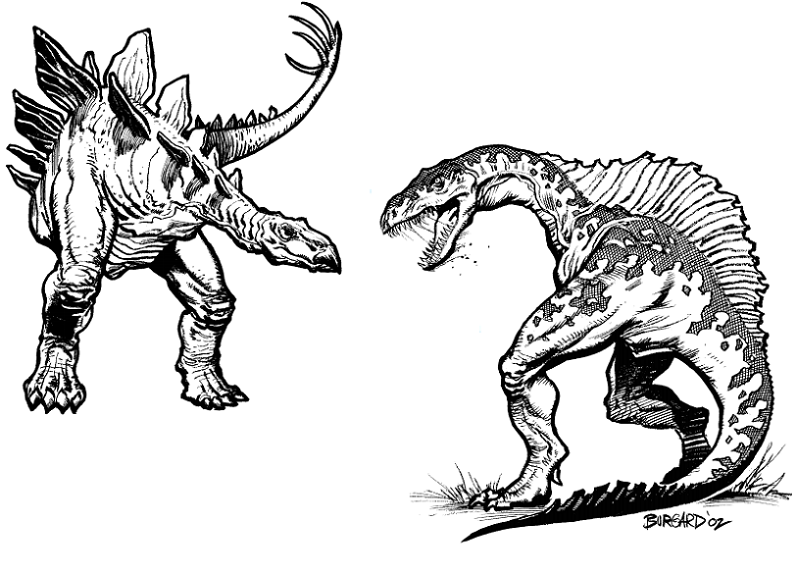
Linnorms ("Worm Dino" or "Slither Lizard") - Acrocanthosaurus linnormus (CR 8), Allosaurus linnormus (CR 8), Carcharodontosaurus linnormus (CR 9), Ceratosaurus (CR 7), Giganotosaurus linnormus (CR 10), Gorgosaurus linnormus (CR 7), Kentrosaurus linnormus (CR 7), Spinosaurus linnormus (CR 9), Stegosaurus linnormus (CR 8), and Tyrannosaurus linnormus (CR 10)
I have to give the writers kudos for almost having a good idea and then managing to make it into the second most stupid entry in this book with a single decision. Most of the linnorms are theropods, whose relatively small arms could theoretically eventually be lost entirely in favor of a completely jaw-centered lifestyle. But no, the writers of Dinosaurs That Never Were don't go with just what speculative evolution writers have put in nearly any spec-evo book that involves dinos, they shoot for the stars and add two stegosaurs into the mix. Fucking stegosaurs , four-legged herbivores! Look at that stego-linnorm in the image. It's like a seesaw of failure. How is that a thing that is supposed to have naturally evolved?
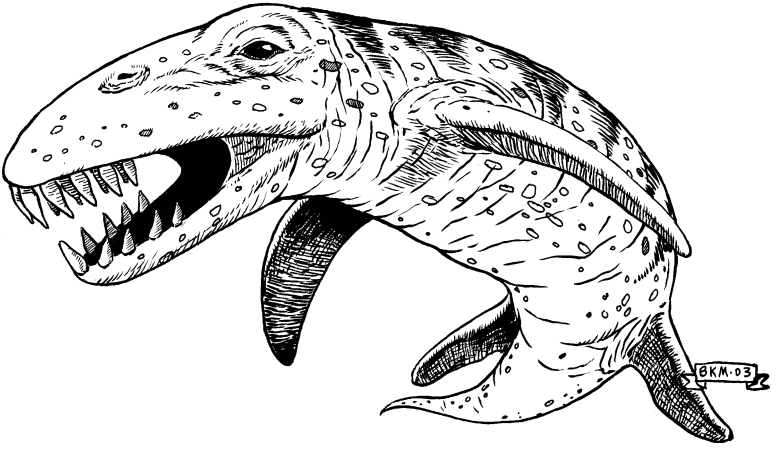
Liopleurodon giganteus ("Swimming Death"; CR 10)
I could go on a rant about how this is another creature larger than a blue whale that somehow doesn't break the class ceiling to reach Challenge Ratings higher than the absolute middle class level of the game, but I won't. Instead, go back and laugh at the stego-linnorm again. It deserves it.
--------------------------
Next time: the designers throw elaborate horns on everything. Again.
Horns, Hominoids, and Headaches
Original SA post
Chapter 2, Part 3: Horns, Hominoids, and Headaches
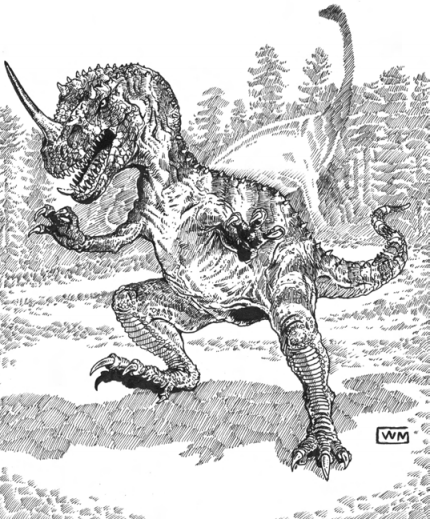
Maleevosaurus nasipilum ("Nose Lancer"; CR 6)
If the blackhorn wasn't quite silly enough, here's yet another theropod that happens to use a horn to stab prey rather than go straight in with its obvious teeth and claws. They are also yet another size Huge theropod that is Chaotic Evil. In other words, nobody cares about them.
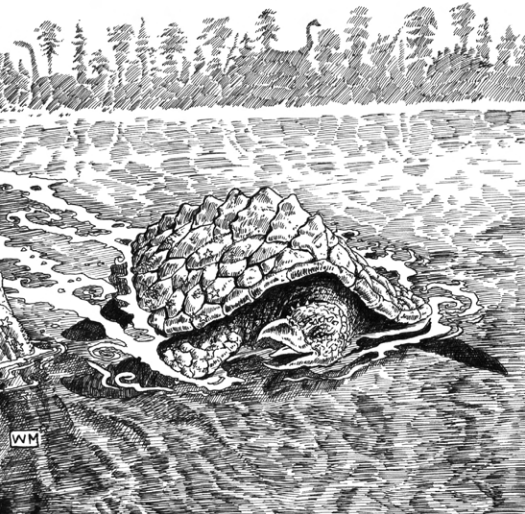
Megalochelys thalassos ("Deep Snapper"; CR 8)
60 feet long and heavily built, the deep snapper is basically the unholy union of an alligator snapping turtle and a sea turtle. It sits on the bottom of the Tempest Sea and flicks its tongue out as a lure. It also is the entry where the references to armor-piercing attacks get even more meta:
Dinosaurs That Never Were posted:
Armor Nullification (Ex):The crushing beak of this enormous sea turtle has so much power in it that the armor bonus of any creature suffering a bite attack is halved, and yes, that includes manmade body armor, and even Union ironclad armor. Sorry.
 "
"
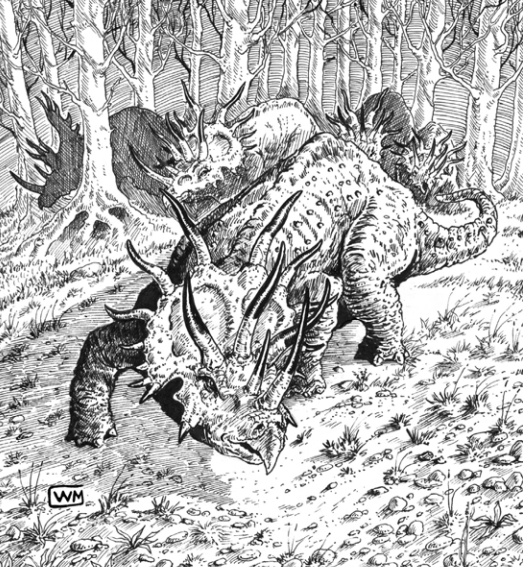
Multiceratops tarbos ("Megahorn"; CR 7)
The megahorn is the ultimate in this book's frivolous horn-sticking. There's a point when you get past 'elaborate' and enter 'anatomically stupid', and we had reached that point back with the horned tank. The megahorn goes past 'anatomically stupid' and enters 'trying too hard to be a heavy metal album cover' territory. As if the display of horns wasn't enough, its coloration is stated to be black with a bone white head that can be turned blood red with the flush of blood vessels. So extreeeee-I don't care.
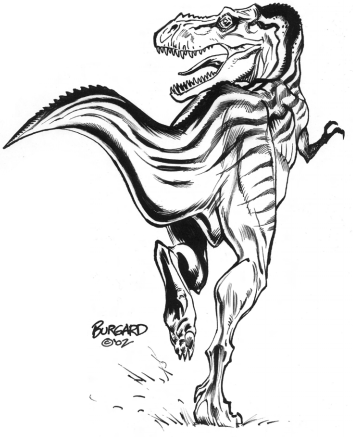
Nanotyrannus acinonyx ("Speed Demon"; CR 4)
Of all the dinosaurs in this book, the speed demon is definitely the most conservative as far as design goes, being pretty much the same as the real life Nanotyrannus lancensis (which may or may not be a juvenile T. rex , but that's beside the point). The only major difference is that the speed demon can move at speeds that surpass those of any creature of the Animal type found in the D&D Monster Manual, allowing it to consistently barrel across the plains in search of prey. It is more or less the unholy hybrid of a speed predator and an endurance predator.
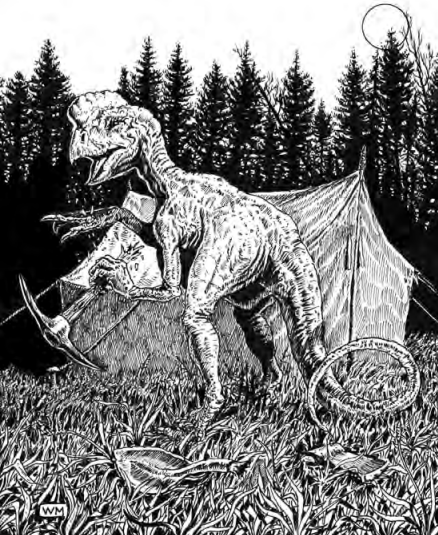
Oviraptor arbrophagus ("Tree Beak"; CR 1)
An oviraptorid that is an indiscriminate omnivore and loves to eat wood that has been "salted" by human sweat. Believe it or not, I actually don't hate this creature. Hell, it works for me on not one, but two, levels! The first is that they are decidedly less of a threat than something like a rust monster, merely dealing double damage against wood rather than just giving a save-or-dissolve or anything of that sort. The second is that I love me some mythology, and the tree beak is clearly meant to evoke the lumberjack folk tales of the wood-gobbling "axehandle hound".
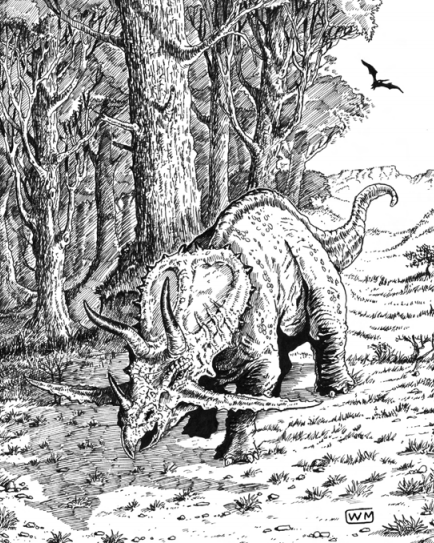
Pentaceratops tarbomonstrum("Blade Dueler"; CR 7)
This, on the other hand, is our third overly-horned ceratopsian of around the same size, similar challenge rating, and possessing the same "double damage on a charge attack" special quality. Yawn.
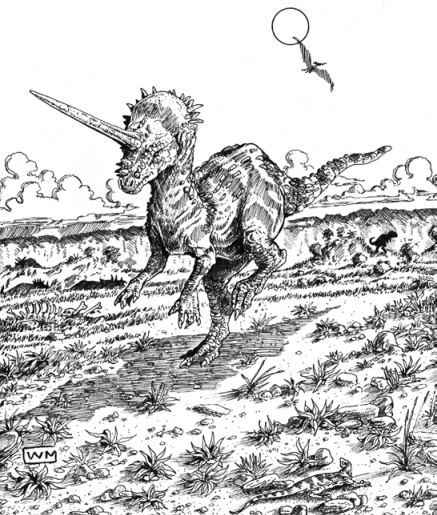
Pilumcephalos velos ("Lance Head"; CR 6)
I...just...what? By sticking a huge unicorn horn in the middle of a pachycephalosaur's dome, you have completely removed the purpose of it being a dome. Look at things like Stygimoloch . Notice how their horns are? Relatively small, out of the way, and not on the fucking ramming dome .
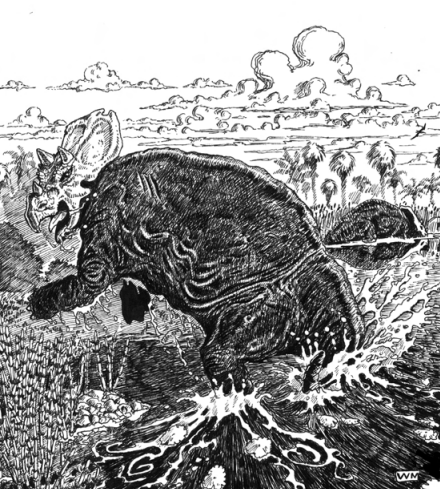
Potamoceratops cretasus ("River Bronco"; CR 8)
Yes, it's a dinosaurian hippo right down to how its behavioral patterns. No, you don't get any points for guessing the obvious.
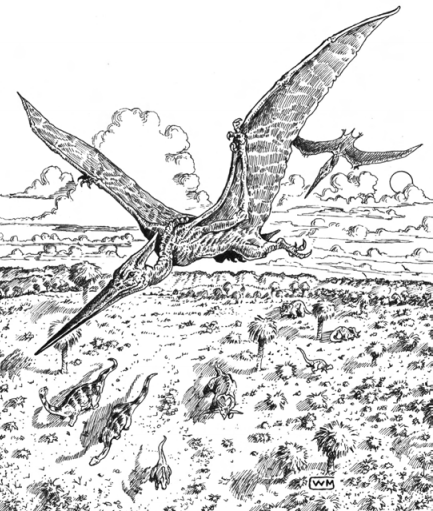
Pteranodon pilumgnathus ("Sword Wing"; CR 4)
Stated to be basically just a more robust version of the real world pterosaur it is an offshoot of. It is a specialist in piercing things with its beak in a manner not unlike a kingfisher, so I can't really give it any red marks for sheer unnatural stupidity.
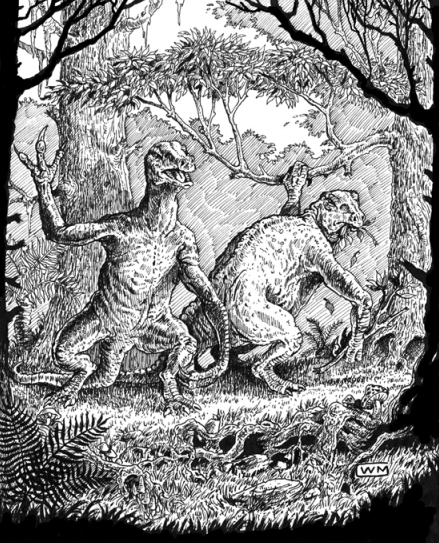
Segnosaurus ursoides ("Ursasaur" or "Bearosaurus"; CR 6)
Just what you'd expect, right down to having a den.
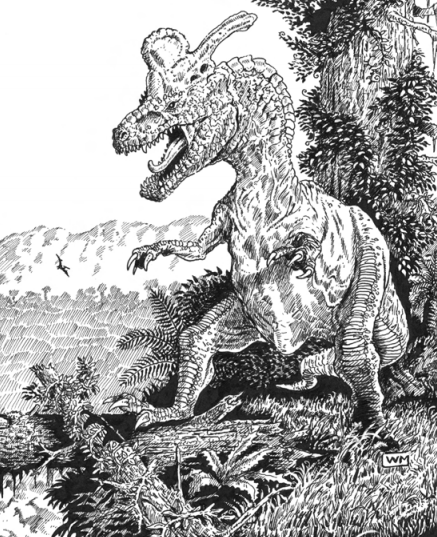
Sirenisaurus macrolophus ("Song Hunter"; CR 7)
I have to give the creators some kudos for the sheer demented creativity of this one. A large theropod that mimics hadrosaur calls? It sort of makes sense in a roundabout way. Maybe I'm just very arbitrary in what I consider plausibly ridiculous as opposed to idiotic, but I can't get any hate flared up for this guy. Besides, he looks so pleased with himself!
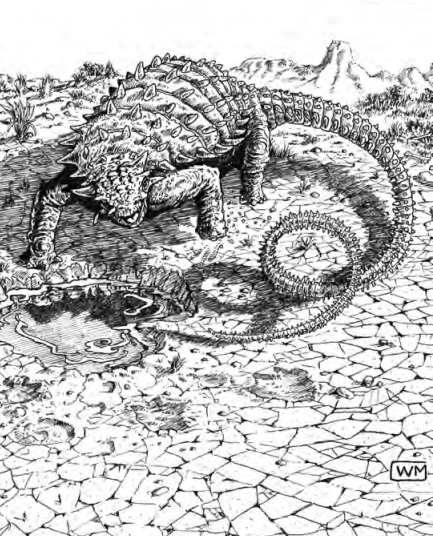
Spinoflagella peloros ("Whiplasher"; CR 7)
This is another one I can't really bring myself to really hate or mock. It takes the nodosaur body plan, alters it in a single plausible manner (longer tail = longer reach = not having to be as close to a predator to deter it), and doesn't horribly botch it.
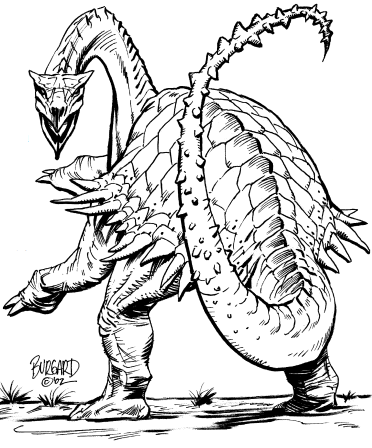
Titanosaurs - Hypselosaurus machairurus, Saltasaurus testudostegos, Spinosauropoda cretasus, Titanosaurus pilumurus, Titanosaurus spinurus, Titanosaurus talarurus ("Tortoisaur"; CR 10)
Yet another one I can't hate! Indeed, this is pretty much the not-completely-idiotic extension of real-life titanosaur evolution, taking the dermal armoring and making it into a full shell. Sure, it still has the Challenge Rating problem, but every creature has that. Things seem to be continuously looking up over these past few entries, and I'm sure the final entry couldn't dash my hopes on jagged rocks!
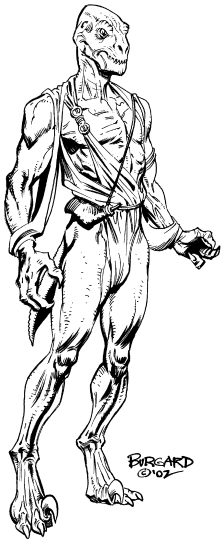
Velociraptor homoides ("Man-Raptor")
...Nevermind.

Yeah, remember the anthropomorphic dinosaurs mentioned in the Stenonychosaurus entry of the Cretasus Adventure Guide? These are them. They are basically the same as Main Valley raptors - they're clever, tribal, have alchemical shamans, the works. The only differences are that they build actual shelters, have traded off their natural weaponry for artificial weaponry, and attack people with thrown beehives. No, really, there's a whole segment on the game mechanics of hives of angry bees being used as projectile weaponry. Why are these creatures hominoid in shape, when normal raptors are just as intelligent but make due with their standard body shapes? Because they really, really wanted a scaly reptoid in the game, I guess.
----------------------------------------
So, that's the final Broncosaurus Rex book ever published, in its entirety. The Eocene-to-Pleistocene "Fur Valley" would have probably been better as the last hurrah instead of teeter-totter two-leg stegosaurs and immortal god-sauropods, but it is what it is.
Next time will be a brief look at what happened to Broncosaurus Rex after its time (including a statement on the vaguely tie-in adventure book from another campaign setting, Southern Discomfort), as well as a general retrospective on the setting.
The Retrospective
Original SA post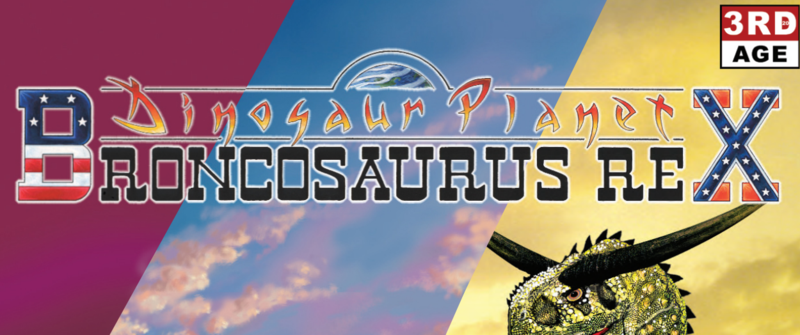
The Retrospective
Well, here we are, at the end of this road. We've managed to go through all three official Broncosaurus Rex books, as the header clearly shows. There are still a few loose ends to tie up and final thoughts to be said, though, so it's retrospective time.
The Odyssey Situation
As someone mentioned previously, there is an adventure from an entirely different game and campaign setting that mentions Broncosaurus Rex. I'm sure everyone here is at least passingly familiar with Eden Studios by now. You know, the Unisystem guys. Well, one of the products they experimented on was a campaign setting called Odyssey Prime, a dual-system campaign setting that had both Unisystem rules and d20 Modern rules provided for it. Does this adventure contribute anything major to Broncosaurus Rex as a campaign setting? The answer is...no, not really.
The adventure "Southern Discomfort" is blatantly meant to be a crossover between Odyssey Prime and Broncosaurus Rex, as the former is all about a government dimension-hopping organization and the latter is an alternate dimension. While there are some generic nmes used in case you don't want to use Broncosaurus Rex for said adventure, it lays out what the adventure is truly referring to fairly early on. The plot is that a group of pirates known as the Grailsmen have stolen an interdimensional rift device and secreted it away in Plesiosaur Bay. This leads to a plesiosaur appearing on our Earth near Fort Sumter in Charleston, South Carolina, where the Odyssey Prime damage control team has to deal with it and a handful of Grailsmen that came through as well. The second half of the adventure leads the Odyssey Prime crew members to Cretasus and into direct conflict with the Grailsmen pirates and their raptor hired muscle. The adventure doesn't really try to reconcile the fact that Broncosaurus Rex uses 3.0 D&D and Odyssey Prime uses either d20 Modern or Unisystem, and more or less expects you to do any further conversions if you plan on following up with more crossover shenanigans.
The Sourcebooks That Never Were
Several sourcebooks were supposedly on the horizon for Broncosaurus Rex as of the publishing of Dinosaurs That Never Were. Two of these supposed future sourcebooks included a Protoceratops sourcebook and a sourcebook on Fur Valley. Time passed, and these never showed up. Some whispers of a 3.5 or d20 Modern revised version of the setting were also spoken of here and there, but again, nothing ever truly showed. Just what happened? I'm not a Goodman Games employee, so I can't really give a definitive answer. Most of what makes up modern Goodman Games materials is either Age of Cthulhu or Dungeons and Dragons 4E, with no real sign that Broncosaurus Rex might ever rise again.
Final Thoughts
While the question of whether or not Broncosaurus Rex will ever return seems to be a definitive "no", the question of whether or not it would be worth resurrecting is up to the individual. Personally, I'd give it a big, hearty maybe . I certainly wouldn't mind a d20 Modern (my favored system, even if it's not perfect) or Savage Worlds (what everyone and their mother suggested for a revised Broncosaurus Rex) revival of the campaign setting, but I wouldn't be heartbroken if it never returned. If it were revived, though, I would definitely suggest it be done somewhat differently:
-
No Confederate Bias: This is a big one for me. Most of the game material is Confederate-focused, the Union is supposedly a viable option but is at the same time painted to be this gravely evil society and only given a few toys to work with, and the extra game mechanics for the Offworlders and Free Fleet are nonexistent.
-
More Modern/Future Materials: There's a lot of mentions of ironclads, spaceships, tanks, and the like being utilized by the Union and (sometimes) the Confederacy, but very few actual pieces are given. Hell, there were never
any
spaceship rules given, presumably to avoid the inevitable question of what is out there in space. For that matter, give some more aliens besides the Scray if you really want to emphasize that it's a big galaxy.
- More Level Variety: I'm rather relieved this is the last time I'll be having to go over this point of reprimand for Broncosaurus Rex. The balance of encounter Challenge Ratings was atrocious, and could have been simply fixed by spreading out the dinosaurs. A Triceratops in D&D is Challenge Rating 9, while the ones in Broncosaurus Rex are merely CR 7, for instance. Why squash everything together, especially when prehistory has some amazingly large and impressive creatures such as Spinosaurus and Kronosaurus ? Why would you squish everything into the first half of the level scaling in a game with 20 character levels? Don't do that!
So there you have it. Broncosaurus Rex, all laid out and bare. It was fun looking back at the quirky and sometimes headscratching design decisions I'd mostly forgotten about, and I can only imagine what will happen in the next set of reviews. After all, I'm going to be going into the Supernatural RPG funerary review blind. Yes, blind.